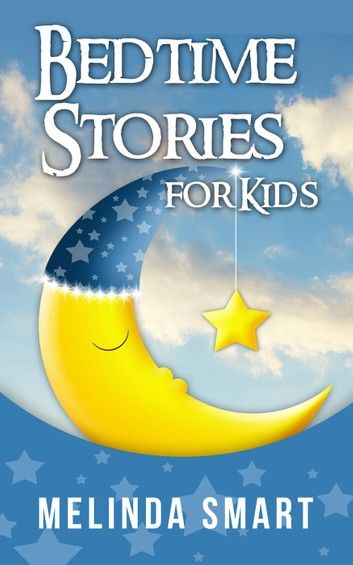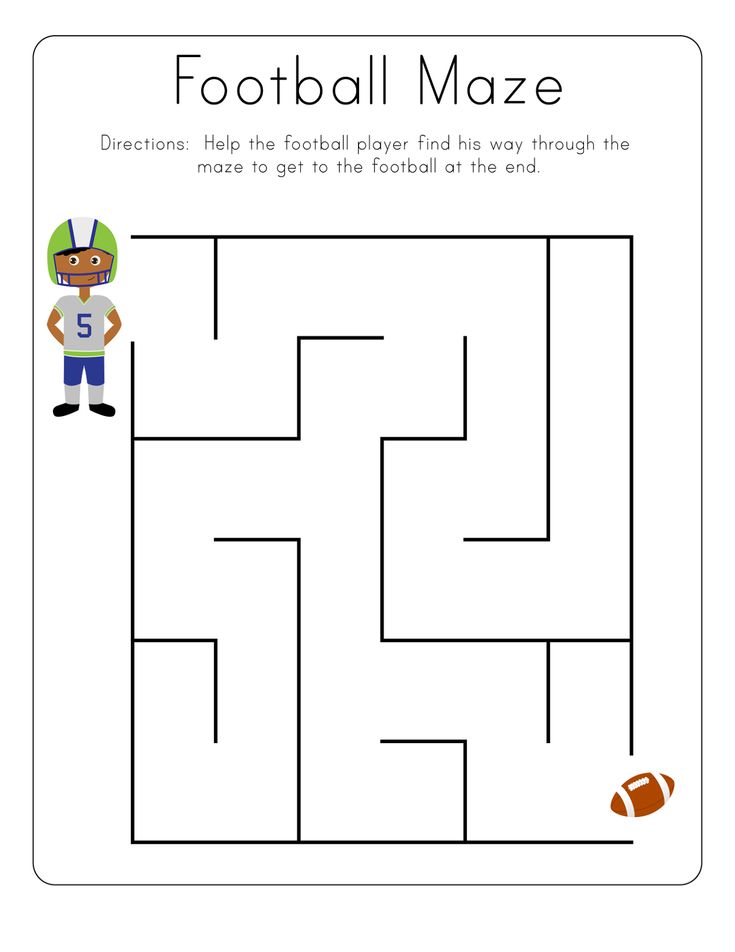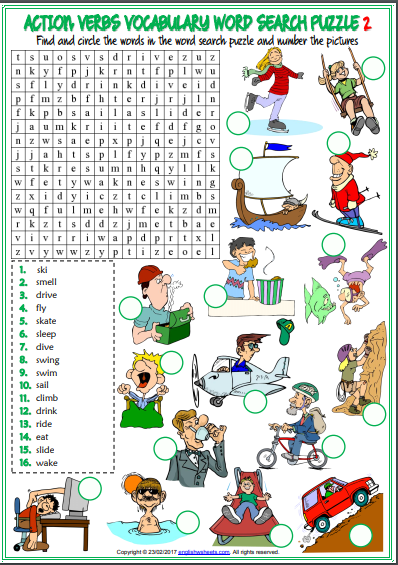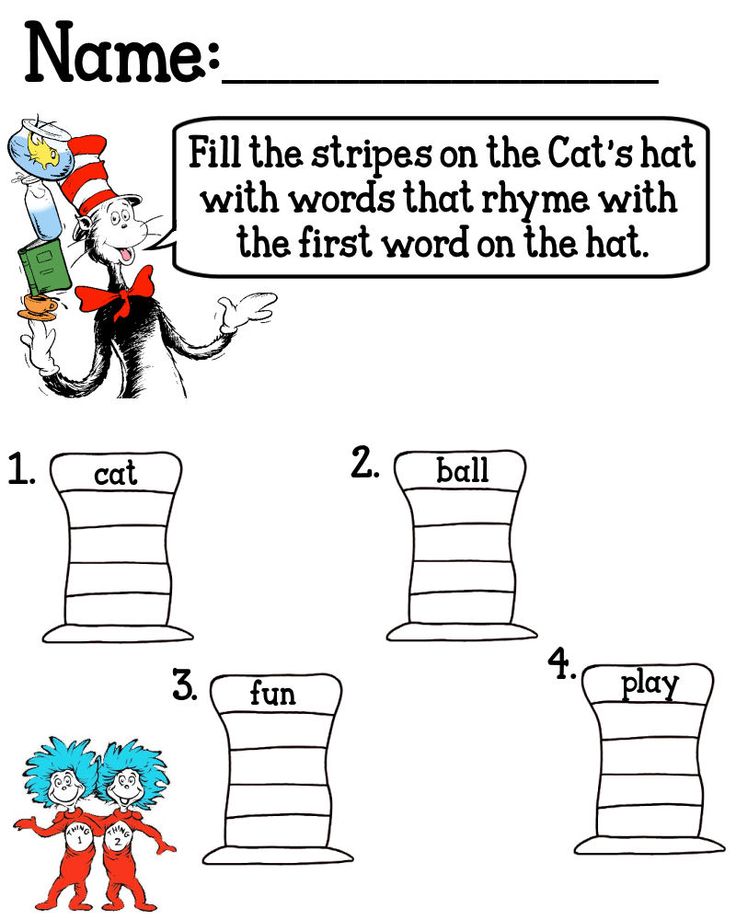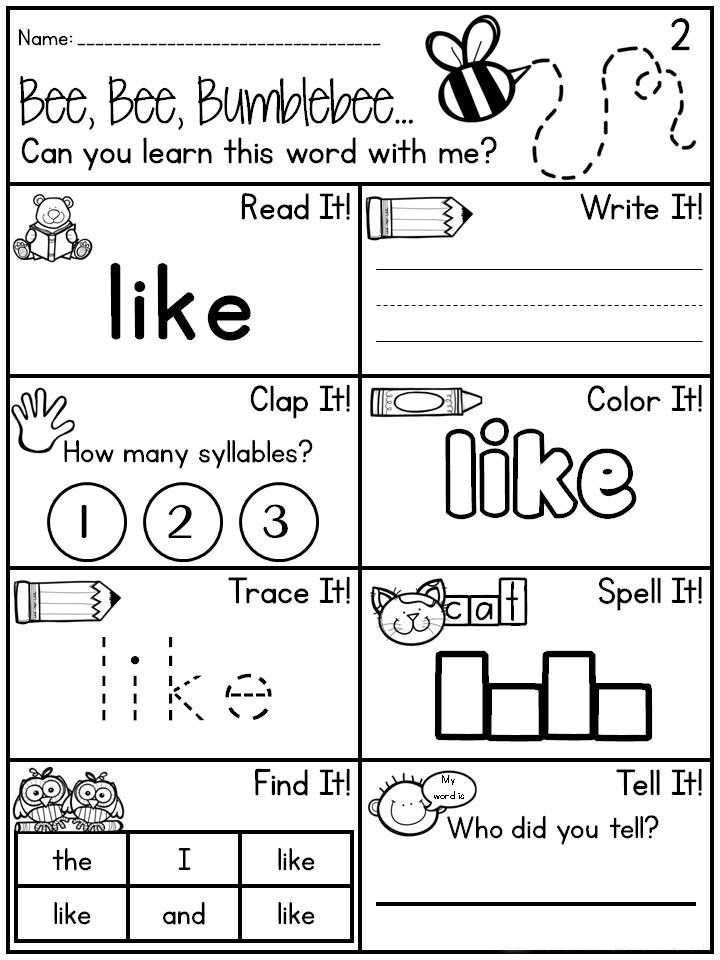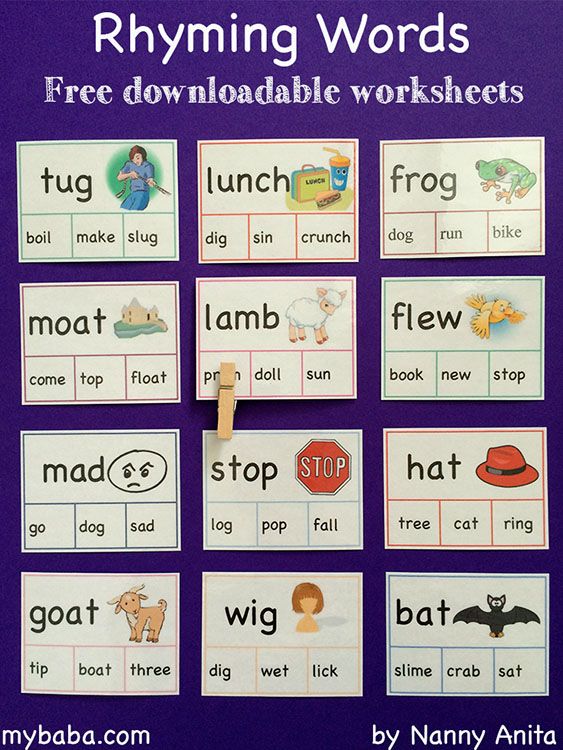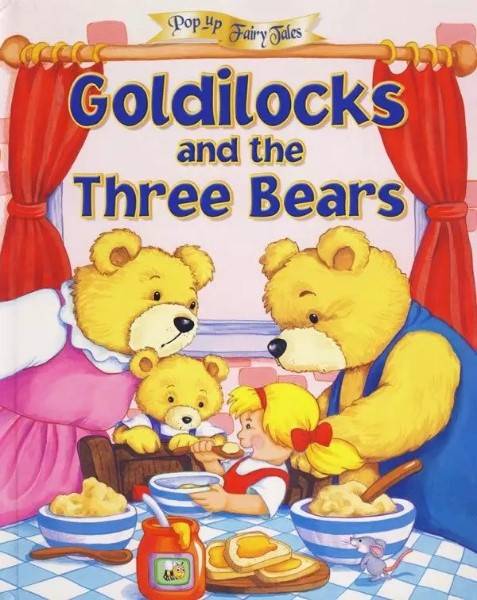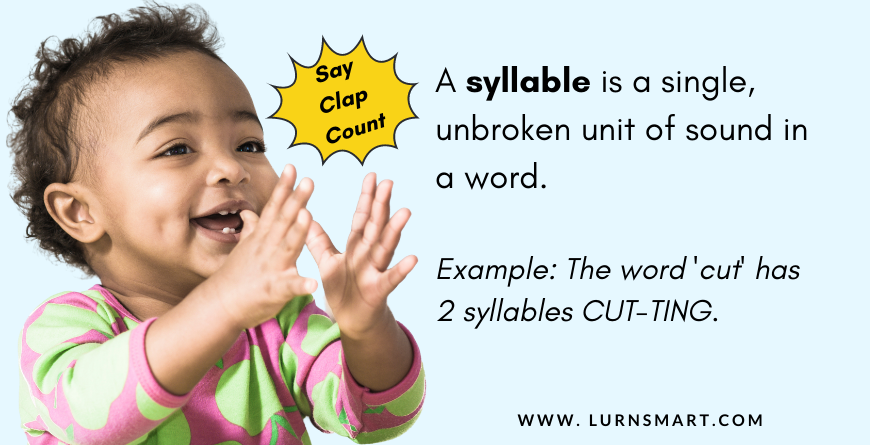Magic beans story
The Story of Jack and the Beanstalk
Old English Fairy Tale - version written and illustrated by Leanne Guenther
Once upon a time, there lived a widow woman and her son, Jack, on their small farm in the country.
Every day, Jack would help his mother with the chores - chopping the wood, weeding the garden and milking the cow. But despite all their hard work, Jack and his mother were very poor with barely enough money to keep themselves fed.
"What shall we do, what shall we do?" said the widow, one spring day. "We don't have enough money to buy seed for the farm this year! We must sell our cow, Old Bess, and with the money buy enough seed to plant a good crop."
"All right, mother," said Jack, "it's market-day today. I'll go into town and sell Bessy."
So Jack took the cow's halter in his hand, walked through the garden gate and headed off toward town. He hadn't gone far when he met a funny-looking, old man who said to him, "Good morning,
Jack. "
"Good morning to you," said Jack, wondering how the little, old man knew his name.
"Where are you off to this fine morning?" asked the man.
"I'm going to market to sell our cow, Bessy."
"Well what a helpful son you are!" exclaimed the man, "I have a special deal for such a good boy like you."
The little, old man looked around to make sure no one was watching and then opened his hand to show Jack what he held.
"Beans?" asked Jack, looking a little confused.
"Three magical bean seeds to be exact, young man. One, two, three! So magical are they, that if you plant them over-night, by morning they grow right up to the sky," promised the funny little man. "And because you're such a good boy, they're all yours in trade for that old milking cow."
"Really?" said Jack, "and you're quite sure they're magical?"
"I am indeed! And if it doesn't turn out to be true you can have your cow back.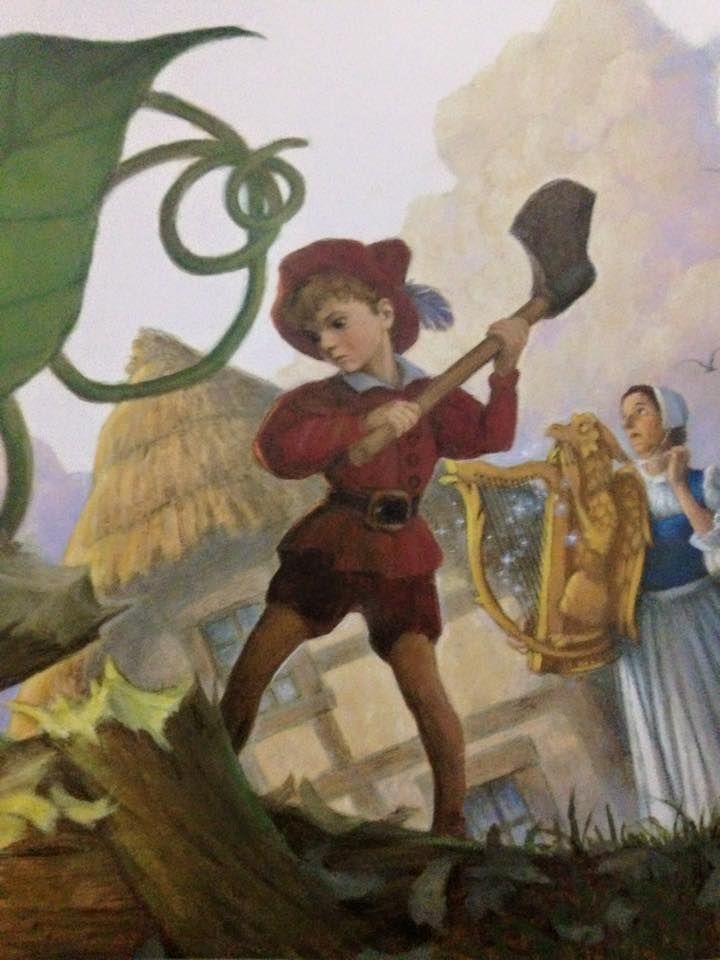 "
"
"Well that sounds fair," said Jack, as he handed over Bessy's halter, pocketed the beans and headed back home to show his mother.
"Back already, Jack?" asked his mother; "I see you haven't got Old Bess -- you've sold her so quickly. How much did you get for her?"
Jack smiled and reached into his pocket, "Just look at these beans, mother; they're magical, plant them over-night and----"
"What!" cried Jack's mother. "Oh, silly boy! How could you give away our milking cow for three measly beans." And with that she did the worst thing Jack had ever seen her do - she burst into tears.
Jack ran upstairs to his little room in the attic, so sorry he was, and threw the beans angrily out the window thinking, "How could I have been so foolish - I've broken my mother's heart." After much tossing and turning, at last Jack dropped off to sleep.
When Jack woke up the next morning, his room looked strange.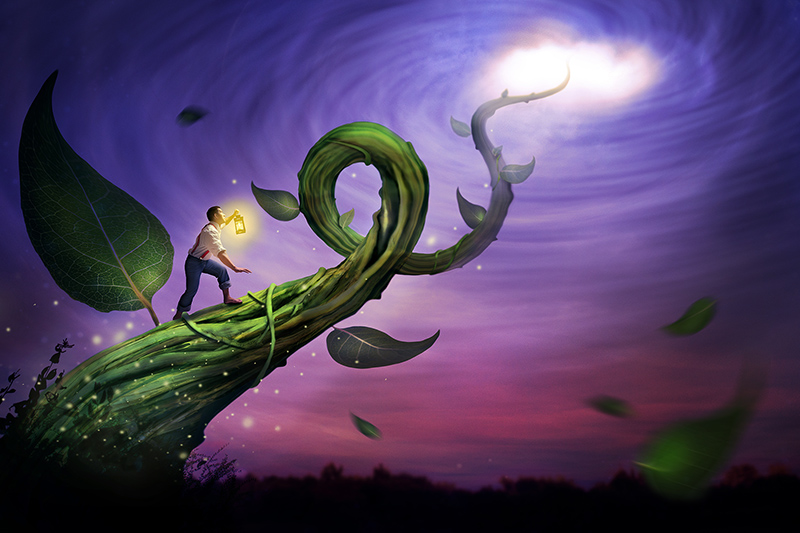 The sun was shining into part of it like it normally did, and yet all the rest was quite dark and shady. So Jack jumped up and
dressed himself and went to the window. And what do you think he saw? Why, the beans he had thrown out of the window into the garden had sprung up into a big beanstalk which went up and up and
up until it reached the sky.
The sun was shining into part of it like it normally did, and yet all the rest was quite dark and shady. So Jack jumped up and
dressed himself and went to the window. And what do you think he saw? Why, the beans he had thrown out of the window into the garden had sprung up into a big beanstalk which went up and up and
up until it reached the sky.
Using the leaves and twisty vines like the rungs of a ladder, Jack climbed and climbed until at last, he reached the sky. And when he got there he found a long, broad road winding its way through the clouds to a tall, square castle off in the distance.
Jack ran up the road toward the castle and just as he reached it, the door swung open to reveal a horrible lady giant, with one great eye in the middle of her forehead.
As soon as Jack saw her he turned to run away, but she caught him, and dragged him into the castle.
"Don't be in such a hurry, I'm sure a growing boy like you would like a nice, big breakfast," said the great, big, tall woman, "It's been so long since I got to make breakfast for a boy.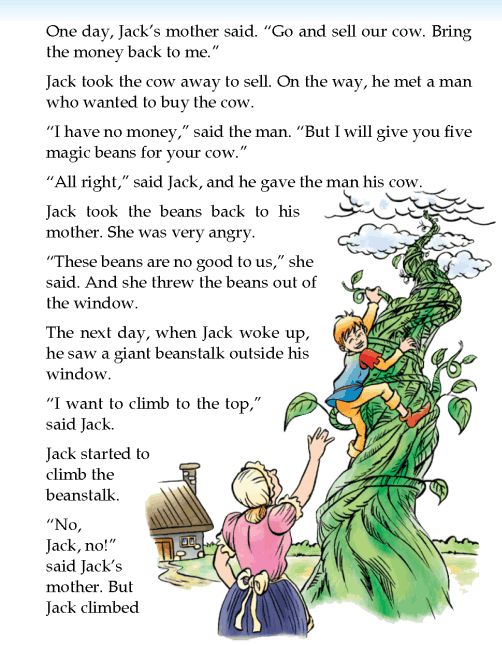 "
"
Well, the lady giant wasn't such a bad sort, after all -- even if she was a bit odd. She took Jack into the kitchen, and gave him a chunk of cheese and a glass of milk. But Jack had only taken a few bites when thump! thump! thump! the whole house began to tremble with the noise of someone coming.
"Goodness gracious me! It's my husband," said the giant woman, wringing her hands, "what on earth shall I do? There's nothing he likes better than boys broiled on toast and I haven't any bread left. Oh dear, I never should have let you stay for breakfast. Here, come quick and jump in here." And she hurried Jack into a large copper pot sitting beside the stove just as her husband, the giant, came in.
He ducked inside the kitchen and said, "I'm ready for my breakfast -- I'm so hungry I could eat three cows. Ah, what's this I smell?
Fee-fi-fo-fum,
I smell the blood of an Englishman,
Be he alive, or be he dead
I'll have his bones to grind my bread.
"Nonsense, dear," said his wife, "we haven't had a boy for breakfast in years. Now you go and wash up and by the time you come back your breakfast'll be ready for you."
So the giant went off to tidy up -- Jack was about to make a run for it when the woman stopped him. "Wait until he's asleep," she said, "he always has a little snooze after breakfast."
Jack peeked out of the copper pot just as the giant returned to the kitchen carrying a basket filled with golden eggs and a sickly-looking, white hen. The giant poked the hen and growled, "Lay" and the hen laid an egg made of gold which the giant added to the basket.
After his breakfast, the giant went to the closet and pulled out a golden harp with the face of a sad, young girl. The giant poked the harp and growled, "Play" and the harp began to play
a gentle tune while her lovely face sang a lullaby. Then the giant began to nod his head and to snore until the house shook.
When he was quite sure the giant was asleep, Jack crept out of the copper pot and began to tiptoe out of the kitchen. Just as he was about to leave, he heard the sound of the harp-girl weeping. Jack bit his lip, sighed and returned to the kitchen. He grabbed the sickly hen and the singing harp, and began to tiptoe back out. But this time the hen gave a cackle which woke the giant, and just as Jack got out of the house he heard him calling, "Wife, wife, what have you done with my white hen and my golden harp?"
Jack ran as fast as he could and the giant, realizing he had been tricked, came rushing after - away from the castle and down the broad, winding road. When he got to the beanstalk the giant was only twenty yards away when suddenly he saw Jack disappear - confused, the giant peered through the clouds and saw Jack underneath climbing down for dear life. The giant stomped his foot and roared angrily.
Fee-fi-fo-fum,
I smell the blood of an Englishman,
Be he alive, or be he dead
I'll have his bones to grind my bread.
The giant swung himself down onto the beanstalk which shook with his weight. Jack slipped, slid and climbed down the beanstalk as quickly as he could, and after him climbed the giant.
As he neared the bottom, Jack called out, "Mother! Please! Hurry, bring me an axe, bring me an axe." And his mother came rushing out with Jack's wood chopping axe in her hand, but when she came to the enormous beanstalk she stood stock still with fright.
Jack jumped down, got hold of the axe and began to chop away at the beanstalk. Luckily, because of all the chores he'd done over the years, he'd become quite good at chopping and it didn't
take long for him to chop through enough of the beanstalk that it began to teeter. The giant felt the beanstalk shake and quiver so he stopped to see what was the matter. Then Jack gave one
last big chop with the axe, and the beanstalk began to topple over. Then the giant fell down and broke his crown, and the beanstalk came toppling after.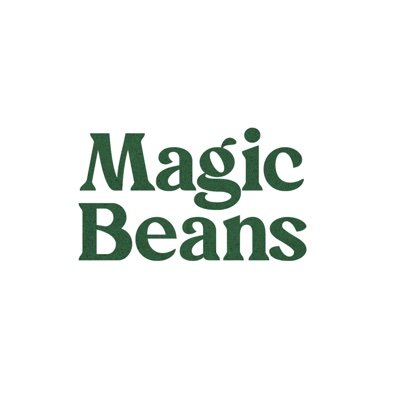
The singing harp thanked Jack for rescuing her from the giant - she had hated being locked up in the closet all day and night and wanted nothing more than to sit in the farmhouse window and sing to the birds and the butterflies in the sunshine.
With a bit of patience and his mother's help, it didn't take long for Jack to get the sickly hen back in good health and the grateful hen continued to lay a fresh golden egg every day.
Jack used the money from selling the golden eggs to buy back Old Bess, purchase seed for the spring crop and to fix up his mother's farm. He even had enough left over to invite every one of his neighbours over for a nice meal, complete with music from the singing harp.
And so Jack, his mother, Old Bess, the golden harp and the white hen lived happy ever after.
Printable version of this story
Templates:
- Close the template window after printing to return to this screen.
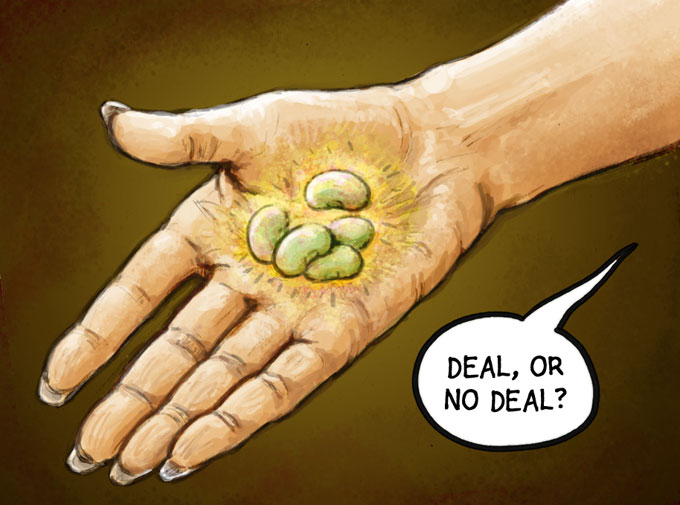
- Set page margins to zero if you have trouble fitting the template on one page (FILE, PAGE SETUP or FILE, PRINTER SETUP in most browsers).
Template Page 1 (color) or (B&W)
Template Page 2 (color) or (B&W)
Template Page 3 (color) or (B&W)
Template Page 4 (color) or (B&W)
Template Page 5 (color) or (B&W)
Template Page 6 (color) or (B&W)
Template Page 7 (color) or (B&W)
Template Page 8 (color) or (B&W)
Template Page 9 (color) or (B&W)
Jack and the Beanstalk
This is the video description for Jack and the Beanstalk This is the video description for Jack and the Beanstalk HOMER is an early learning program for kids ages 2-8.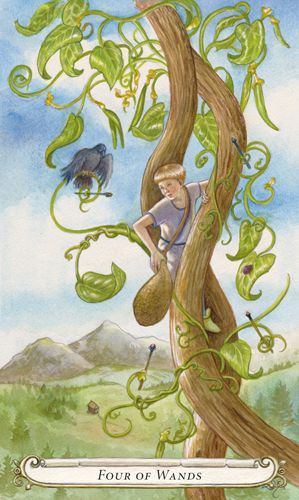 It includes access to hundreds of interactive stories and a personalized learn-to-read plan. Try it free for 30 days! Jack’s tired of milking his old cow, so he decides to sell her at the market. On the way, a peddler convinces Jack to trade the cow for magic beans, and his mother’s none too happy about it. When she tosses the beans out the window and a beanstalk shoots up into the sky, Jack just can’t resist finding out what’s at the top—a giant castle! There he finds a goose that can lay golden eggs, and . . . what’s that? “Fee fi fo fummy!” It’s a giant that thinks Jack smells “yum, yum, yummy!” But when the giant follows Jack down the beanstalk, Jack and the giant find a way to become friends. show full description Show Short Description
It includes access to hundreds of interactive stories and a personalized learn-to-read plan. Try it free for 30 days! Jack’s tired of milking his old cow, so he decides to sell her at the market. On the way, a peddler convinces Jack to trade the cow for magic beans, and his mother’s none too happy about it. When she tosses the beans out the window and a beanstalk shoots up into the sky, Jack just can’t resist finding out what’s at the top—a giant castle! There he finds a goose that can lay golden eggs, and . . . what’s that? “Fee fi fo fummy!” It’s a giant that thinks Jack smells “yum, yum, yummy!” But when the giant follows Jack down the beanstalk, Jack and the giant find a way to become friends. show full description Show Short Description Fairy Tales
Browse our collection of fairy tales including those made famous by The Brothers Grimm and Hans Christian Andersen
view all
Jack and the Beanstalk
Goldilocks and the Three Bears
Goldilocks
Harold's Fairy Tale
Little Red Riding Hood
The Three Little Pigs
Three Little Pigs
One membership, two learning apps for ages 2-8.
TRY IT FOR FREE
Full Text
Once upon a time, a boy named Jack got himself into the biggest, most humongous heap of trouble ever. It all started when Jack’s mama asked him to milk the old cow. But Jack decided he was tired of milking cows. “No way, no how. I’m not milking this brown cow now,” said Jack, and he decided to sell the old cow, so he’d never have to milk it again! Jack was on his way to market to sell the cow when he came across a peddler. “Hi, Mr. Peddler,” said Jack. “Where are you headed?” asked the peddler. “I’m going to sell my cow at the market,” Jack answered. “Why sell your cow?” asked the peddler. “Trade her for beans!” “Beans?” asked Jack. “Not just any kind of beans,” said the peddler, “magic beans.” “What do they do?” asked Jack. “They do magic!” said the peddler. “Magic? Sold!” said Jack, and he traded the cow for three magic beans. Jack got home and told his mama he had sold the cow so he wouldn’t have to milk her anymore.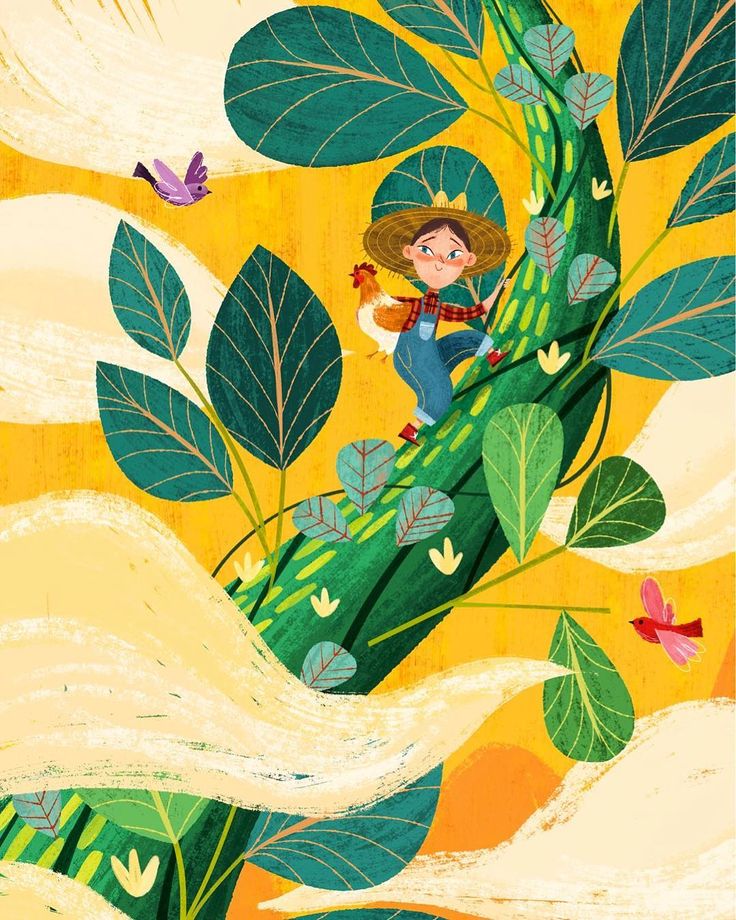 “Oh dear, you did what?” Jack’s mama asked. “I sold her for magic beans,” said Jack. “You sold a cow for magic beans?” Jack’s mama couldn’t believe what Jack was telling her. “There’s no such thing as magic beans,” she said as she threw the beans out the window. “Well, I did make them disappear, but that still doesn’t make them magic!” Suddenly, the ground rumbled and began to shake. A magic beanstalk grew up right before their eyes! Jack saw it and immediately began to climb the tall beanstalk. “Get back here this instant!” called Jack’s mama, but Jack wasn’t listening. Jack climbed up and up and up and up the beanstalk. At the top of the beanstalk, Jack found a giant castle. He walked up to the giant door, cracked it open, and went inside. Inside the castle, Jack saw the most amazing thing he had ever seen. It was a goose. But it wasn’t just any old ordinary goose. This goose laid eggs made of gold! “That is so cool,” thought Jack. “Think of all the things you could do with golden eggs!” And then, Jack got the worst idea he’d ever had—he was going to take the goose! Jack lifted the goose off of its perch.
“Oh dear, you did what?” Jack’s mama asked. “I sold her for magic beans,” said Jack. “You sold a cow for magic beans?” Jack’s mama couldn’t believe what Jack was telling her. “There’s no such thing as magic beans,” she said as she threw the beans out the window. “Well, I did make them disappear, but that still doesn’t make them magic!” Suddenly, the ground rumbled and began to shake. A magic beanstalk grew up right before their eyes! Jack saw it and immediately began to climb the tall beanstalk. “Get back here this instant!” called Jack’s mama, but Jack wasn’t listening. Jack climbed up and up and up and up the beanstalk. At the top of the beanstalk, Jack found a giant castle. He walked up to the giant door, cracked it open, and went inside. Inside the castle, Jack saw the most amazing thing he had ever seen. It was a goose. But it wasn’t just any old ordinary goose. This goose laid eggs made of gold! “That is so cool,” thought Jack. “Think of all the things you could do with golden eggs!” And then, Jack got the worst idea he’d ever had—he was going to take the goose! Jack lifted the goose off of its perch.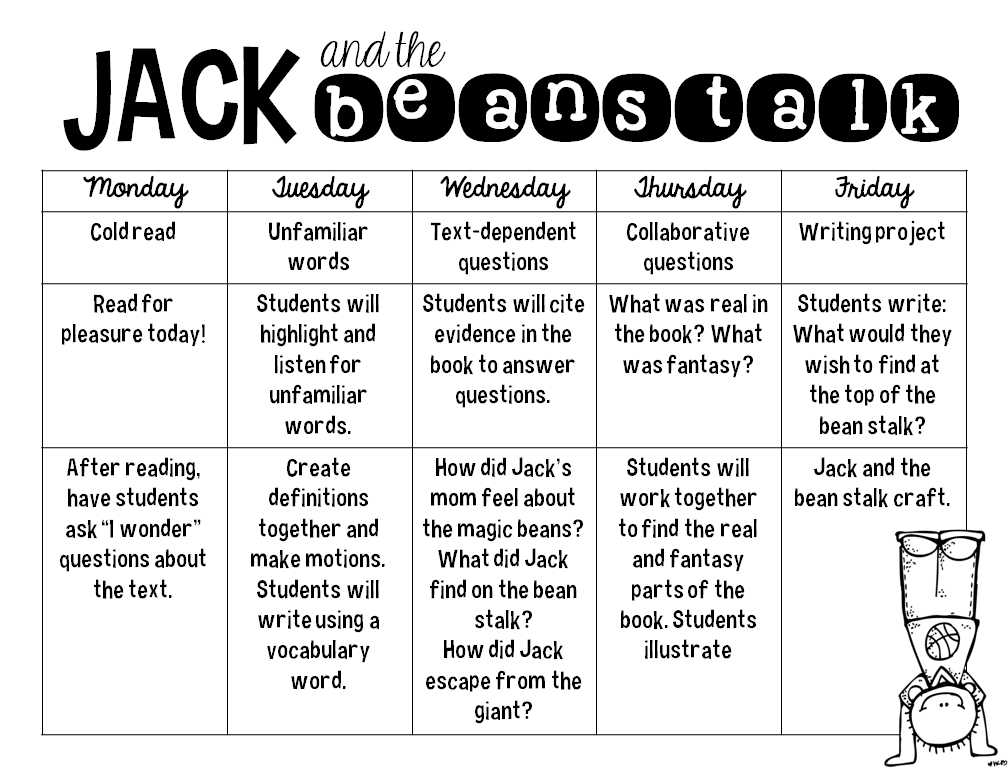 Just then, the biggest, most fearsome, and only giant Jack had ever seen came into the room. The giant saw that his goose wasn’t in its usual spot! “Fee fi fo funch, if you took my goose, I’ll eat you for lunch!” “Oh no,” thought Jack. “That giant’s going to eat me! I’ve got to get out of here without him seeing me!” Quietly and carefully, Jack took the goose and made his way toward the door. He was almost out of the room when—honk! The goose cried out and the giant spotted Jack! “Fee fi fo fummy, give that back or I’ll call my mummy!” roared the giant. “Ahhh!” screamed Jack. He ran toward the beanstalk. Jack ran as quickly as he could down the beanstalk, but the giant was following close behind. Just as Jack put his feet back on the ground, the giant picked up Jack in his enormous hands. “Fee fi fo fummy, I bet you taste yum yum yummy!” said the giant. Just as the giant was about to eat Jack, the ground began to shake, and there, standing right behind the giant, was an even bigger, taller, more humongous lady giant! “Two giants!” thought Jack.
Just then, the biggest, most fearsome, and only giant Jack had ever seen came into the room. The giant saw that his goose wasn’t in its usual spot! “Fee fi fo funch, if you took my goose, I’ll eat you for lunch!” “Oh no,” thought Jack. “That giant’s going to eat me! I’ve got to get out of here without him seeing me!” Quietly and carefully, Jack took the goose and made his way toward the door. He was almost out of the room when—honk! The goose cried out and the giant spotted Jack! “Fee fi fo fummy, give that back or I’ll call my mummy!” roared the giant. “Ahhh!” screamed Jack. He ran toward the beanstalk. Jack ran as quickly as he could down the beanstalk, but the giant was following close behind. Just as Jack put his feet back on the ground, the giant picked up Jack in his enormous hands. “Fee fi fo fummy, I bet you taste yum yum yummy!” said the giant. Just as the giant was about to eat Jack, the ground began to shake, and there, standing right behind the giant, was an even bigger, taller, more humongous lady giant! “Two giants!” thought Jack.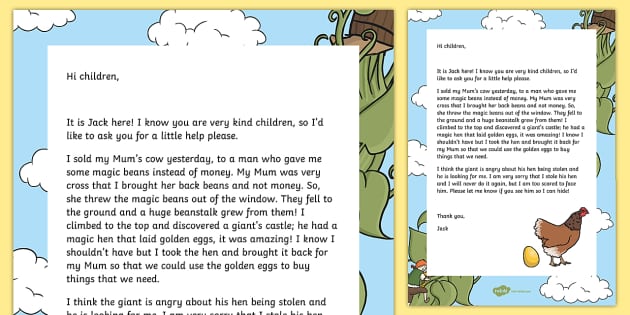 “They’ll eat me now for sure!” “Put that boy down, Willifred,” the giant mama told her son. The giant put Jack back down on the ground. “Now what have I told you?” she asked. “Don’t eat other kids,” said the giant sheepishly. “That’s right, we don’t eat other kids,” said the mama giant. “But he took my goose!” cried the giant. Just then, Jack’s mama came out of the farmhouse. “What on earth is going on here?” she asked. “Well,” Jack began, “there was this castle, and inside was the coolest goose ever—it lays golden eggs! As I was taking it, this giant kid came in and was all ‘fee fi fo fum’ and then I—” “You mean you took this boy’s goose?” Jack’s mama interrupted. “Yeah, but it lays golden eggs!” Jack paused and thought about it. “Huh. Now that you mention it, I guess that wasn’t very nice,” said Jack. Jack looked at the giant. “I’m sorry I took your goose. I know I shouldn’t take things that don’t belong to me.” “That’s OK. I suppose I should’ve asked you to give me back the goose without trying to eat you.
“They’ll eat me now for sure!” “Put that boy down, Willifred,” the giant mama told her son. The giant put Jack back down on the ground. “Now what have I told you?” she asked. “Don’t eat other kids,” said the giant sheepishly. “That’s right, we don’t eat other kids,” said the mama giant. “But he took my goose!” cried the giant. Just then, Jack’s mama came out of the farmhouse. “What on earth is going on here?” she asked. “Well,” Jack began, “there was this castle, and inside was the coolest goose ever—it lays golden eggs! As I was taking it, this giant kid came in and was all ‘fee fi fo fum’ and then I—” “You mean you took this boy’s goose?” Jack’s mama interrupted. “Yeah, but it lays golden eggs!” Jack paused and thought about it. “Huh. Now that you mention it, I guess that wasn’t very nice,” said Jack. Jack looked at the giant. “I’m sorry I took your goose. I know I shouldn’t take things that don’t belong to me.” “That’s OK. I suppose I should’ve asked you to give me back the goose without trying to eat you.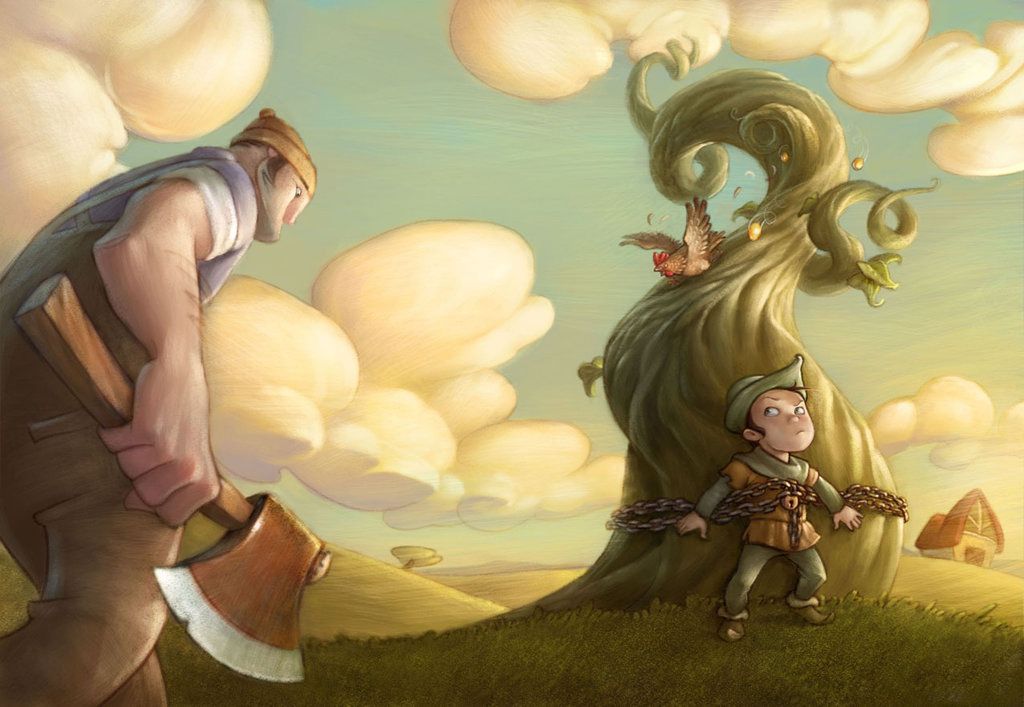 I’m sorry too,” said the giant. “Hey, do you want to play baseball?” Jack and the giant became good friends, using the beanstalk to visit each other whenever they wanted. “You know,” Jack said, “if it weren’t for those three magic beans, I never would have learned how to play giant baseball.” “You’re right,” said the giant. “I’d say the whole adventure was a giant success!”
I’m sorry too,” said the giant. “Hey, do you want to play baseball?” Jack and the giant became good friends, using the beanstalk to visit each other whenever they wanted. “You know,” Jack said, “if it weren’t for those three magic beans, I never would have learned how to play giant baseball.” “You’re right,” said the giant. “I’d say the whole adventure was a giant success!”
1
We take your child's unique passions
2
Add their current reading level
3
And create a personalized learn-to-read plan
4
That teaches them to read and love reading
TRY IT FOR FREE
Jack and the Magic Bean - frwiki.wiki
For the articles of the same name, see Jack and the Magic Bean (disambiguation).
Jack and the Beanstalk is a fairy tale popular in English.
It bears some resemblance to Jack the Giant Slayer , another Cornish hero tale. The origin of Jack and Beanstalk is unknown. We can see in the parody version which appeared in the first half of XVIII - th centuries the first literary version of the story. In 1807, Benjamin Tabart published in London a moralizing version closer to what is known today. The story was subsequently popularized by Henry Cole in The Home Treasury (1842) and Joseph Jacobs gave another version in English Tales (1890). The latter is the version most often reproduced in English-language collections today, and due to its lack of morality and "dry" literary treatment, it is often considered a truer oral version than Tabart's. However, there can be no certainty in this matter.
The origin of Jack and Beanstalk is unknown. We can see in the parody version which appeared in the first half of XVIII - th centuries the first literary version of the story. In 1807, Benjamin Tabart published in London a moralizing version closer to what is known today. The story was subsequently popularized by Henry Cole in The Home Treasury (1842) and Joseph Jacobs gave another version in English Tales (1890). The latter is the version most often reproduced in English-language collections today, and due to its lack of morality and "dry" literary treatment, it is often considered a truer oral version than Tabart's. However, there can be no certainty in this matter.
Jack and the Beanstalk is one of the most famous folk tales and has been the subject of many adaptations in various forms until today.
Summary
- 1 First printed versions
- 2 Summary (Jacobs version)
- 3 variants
- 4 Structure
- 5 Classification
- 6 Fee-fi-fo-fum formula
- 7 parallels in other fairy tales
- 8 Patterns and ancient origins of these
- 9 Morality
- 10 interpretations
- 11 Illustrations
- 12 Modern adaptations
- 12.
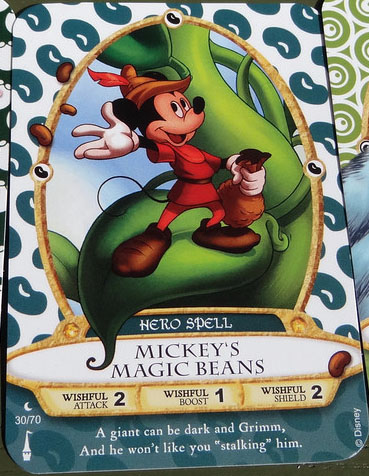 1 Cinema
1 Cinema - 12.2 Television and video
- 12.3 Video games
- 12.4 Exhibitions
- 12.
- 13 Notes and references
- 14 Bibliography
- 14.1 Versions / editions of fairy tale
- 14.2 Research
- 14.3 Symbolic
- 14.4 About adaptation
- 15 See also
- 15.1 Related Articles
First printed versions
The origin of this tale is not exactly known, but it is believed to have British roots.
According to Iona and Peter Opie, the first literary version of the tale is The Charm Shown in the Story of Jack Spriggins and the Enchanted Bean , which appears in the 1734 English edition of Round of Our Charcoal Fire or Christmas Fun , a collection that includes the First Edition, which did not include the tale, is dated 1730. Then this is a parody version that makes fun of the fairy tale, but nevertheless testifies on the part of the author of a good knowledge of the traditional fairy tale.
Frontispiece (" Jack fleeing the giant ") and title page "The story of Jack and the beanstalk" , B. Tabart, London, 1807.
when two books were published: "The Story of Mother Twaddle" and "The Wonderful Achievements of Her Son Jack" with the single initials " Bat " as the author's name. and Jack and Bob's Story , published in London by Benjamin Tabart. In the first case, this is a poetic version, which differs significantly from the known version: a servant takes Jack to the giant's house, and she gives the latter beer to put him to sleep; as soon as the giant falls asleep, Jack decapitates him; He then marries a maid and sends for his mother. Another version, whose title page states that it is a version "printed from an original manuscript, never before published", is closer to the tale as we know it today, except that it has a fairy character, which gives the moral of the story.
In 1890, Joseph Jacobs reported in English Tales a version of Jack and the Beanstalk which he said was based on "oral versions heard in his boyhood in Australia about 1860" and in which he took the side of "ignoring excuse".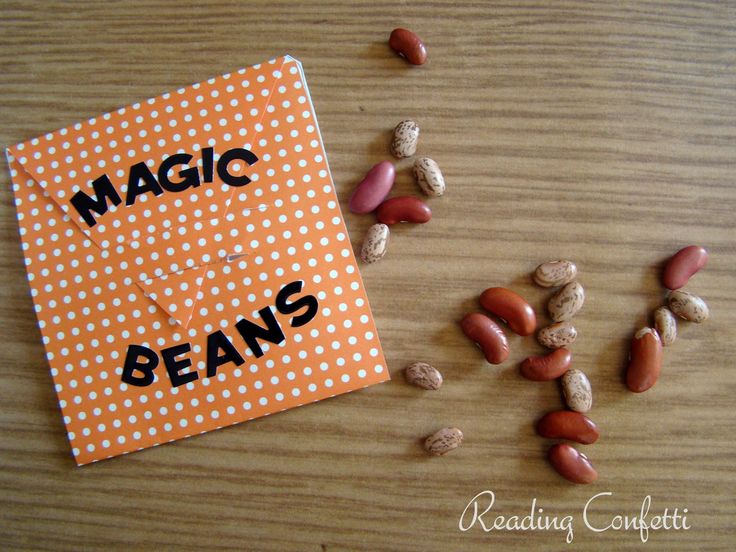 given by Tabart for Jack who killed the giant. Subsequently, other versions of the tale will follow sometimes Tabart, who therefore justifies the hero's actions, sometimes Jacobs, who presents Jack as a steadfast deceiver. So Andrew Lang at Red Fairy Book , also published in 1890, follows Tabart. From Tabart/Lang or Jacobs, it is difficult to determine which of the two versions is closer to the oral version: while specialists such as Katherine Briggs, Philip Neal or Maria Tatar prefer Jacobs' version, others such as Jonah and Peter Opie consider it should be “nothing but a reworking of a text that has continued to be printed for more than half a century. "
given by Tabart for Jack who killed the giant. Subsequently, other versions of the tale will follow sometimes Tabart, who therefore justifies the hero's actions, sometimes Jacobs, who presents Jack as a steadfast deceiver. So Andrew Lang at Red Fairy Book , also published in 1890, follows Tabart. From Tabart/Lang or Jacobs, it is difficult to determine which of the two versions is closer to the oral version: while specialists such as Katherine Briggs, Philip Neal or Maria Tatar prefer Jacobs' version, others such as Jonah and Peter Opie consider it should be “nothing but a reworking of a text that has continued to be printed for more than half a century. "
Jack trades his cow for beans. Illustration by Walter Crane.
Summary (Jacobs version)
In Jacobs' version of the tale, Jack is a boy who lives alone with his widowed mother. Their only source of existence is milk from a single cow. One morning they realize that their cow is no longer producing milk. Jack's mother decides to send her son to sell her in the market.
Jack's mother decides to send her son to sell her in the market.
Along the way, Jack meets a strange looking old man who greets Jack by his first name. He manages to convince Jack to trade his cow for beans, he says "magic": if we plant them at night, in the morning they will grow to heaven! When Jack returns home with no money but only a handful of beans, his mother gets angry and throws the beans out the window. She punishes her son for his gullibility by sending him to bed without supper.
« Fee-foo-foom, I can smell the Englishman's blood. ". Arthur Rackham's illustration from English Tales by Flora Annie Steele, 1918.
While Jack sleeps, the beans sprout from the ground, and by morning a giant stalk of beans has grown in the place where they were thrown. , Jack sees a huge rod rising into the sky and decides to immediately climb to its top.
At the top he finds a broad road which he chooses and which leads him to a large house.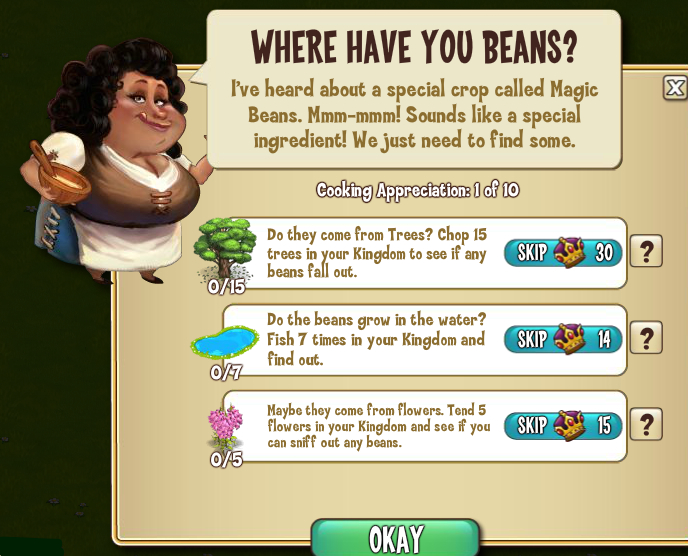 On the threshold of a large house stands a large woman. Jack asks her to offer him dinner, but the woman warns him: her husband is a cannibal, and if Jack doesn't turn around, he risks serving dinner to her husband. Jack insists, and the giantess cooks a meal for him. Jack is not halfway to the meal when footsteps are heard, causing the whole house to shake. The giantess hides Jack in the oven. The ogre appears and immediately senses the presence of a human:
On the threshold of a large house stands a large woman. Jack asks her to offer him dinner, but the woman warns him: her husband is a cannibal, and if Jack doesn't turn around, he risks serving dinner to her husband. Jack insists, and the giantess cooks a meal for him. Jack is not halfway to the meal when footsteps are heard, causing the whole house to shake. The giantess hides Jack in the oven. The ogre appears and immediately senses the presence of a human:
« Phi-fi-fo-foom!
I smell the blood of an Englishman,
whether he is alive or dead,
I will have his bones to grind my bread. "
What does it mean:
« Phi-fi-fo-foom!
I sniff the blood of an Englishman,
Dead or alive,
I have to grind his bones to make bread. "
The ogre's wife tells him that he has his own thoughts and that the smell he smells is probably the smell of the remains of a little boy that he enjoyed the day before.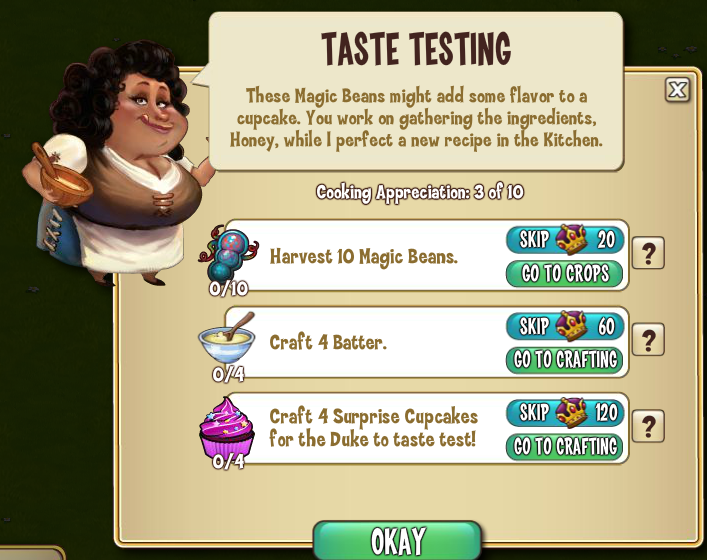 The ogre leaves, and as Jack is ready to jump out of his hiding place and wrap his legs around his neck, the giantess tells him to wait until her husband naps. After the ogre swallows, Jack sees him take some bags from the chest and count the gold coins in them until he falls asleep. So Jack tiptoes out of the oven and runs off carrying one of the bags of gold. He descends the bean stalk and brings gold to his mother.
The ogre leaves, and as Jack is ready to jump out of his hiding place and wrap his legs around his neck, the giantess tells him to wait until her husband naps. After the ogre swallows, Jack sees him take some bags from the chest and count the gold coins in them until he falls asleep. So Jack tiptoes out of the oven and runs off carrying one of the bags of gold. He descends the bean stalk and brings gold to his mother.
Jack escapes a third time, carrying a magic harp. The ogre is on his trail. Illustration by Walter Crane.
Gold allows Jack and his mother to live for a while, but there comes a time when it all disappears and Jack decides to return to the top of the bean stalk. On the threshold of a large house, he again finds the giantess. She asks him if he had already arrived the day her husband noticed one of her bags of gold was missing. Jack tells her that he is hungry and cannot talk to her until he has eaten. The giantess prepares food for him again .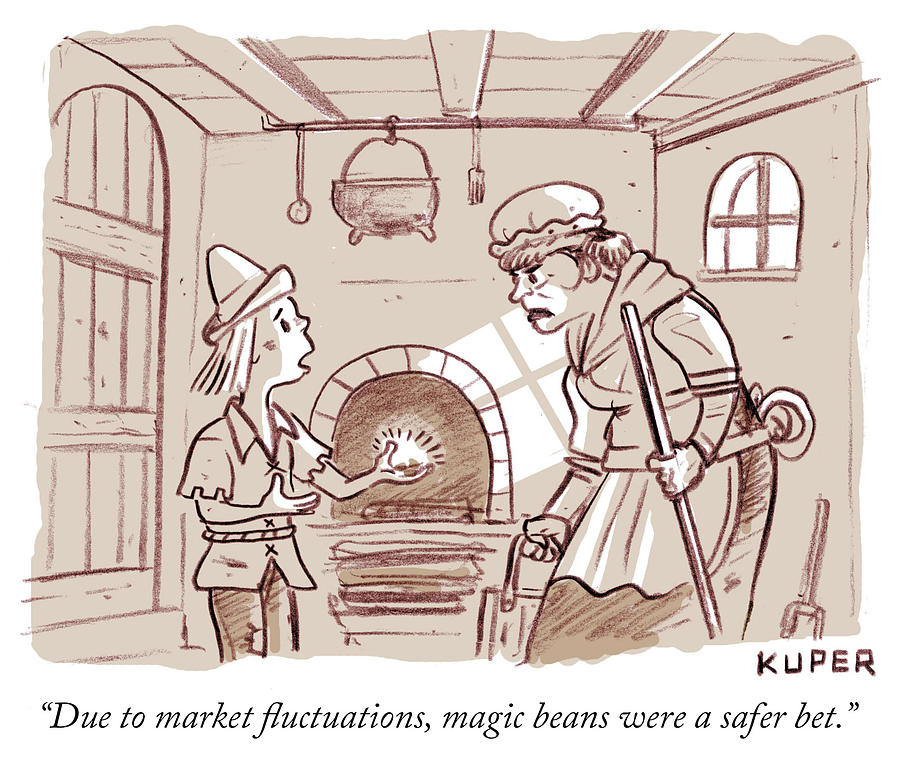 .. Everything goes like last time, but this time Jack manages to steal a goose that every time we say "ponds" lays a golden egg. He returns her to his mother.
.. Everything goes like last time, but this time Jack manages to steal a goose that every time we say "ponds" lays a golden egg. He returns her to his mother.
Soon an unsatisfied Jack feels the urge to climb back to the top of the bean stalk. So the third time he climbs up the stick, but instead of going straight to the big house, when he comes to it, he hides behind a bush and waits before entering the house. Ogre, that giantess went out for water. There is another cache in the house, in a "pot". A couple of giants are back. Once again, the ogre senses Jack's presence. The giantess then tells her husband to look in the oven because that's where Jack used to hide. Jack is gone and they think it is the smell of the woman the ogre ate the day before. After dinner, the ogre asks his wife to bring him a golden harp. The harp sings until the ogre falls asleep, and Jack takes the opportunity to get out of his hiding place. When Jack grabs the harp, she calls her master an ogre with a human voice, and the ogre wakes up.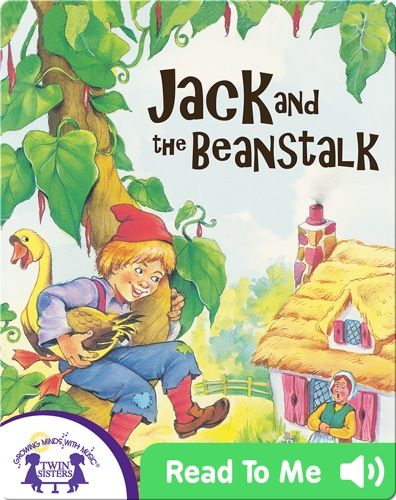 The ogre chases Jack, who has grabbed the harp, towards the beanstalk. The ogre comes down the rod behind Jack, but as soon as Jack goes down, he quickly asks his mother to give him an ax with which he cuts the huge rod. The ogre falls and "breaks his crown".
The ogre chases Jack, who has grabbed the harp, towards the beanstalk. The ogre comes down the rod behind Jack, but as soon as Jack goes down, he quickly asks his mother to give him an ax with which he cuts the huge rod. The ogre falls and "breaks his crown".
Jack shows his mother a golden harp, and thanks to her and the sale of golden eggs, they both become very rich. Jack marries a great princess. And then they live happily ever after?
Variants
Three flights are missing from the 1734 parody version and the 1807 "BAT" version, but not from the bean stalk. In Tabart's version (1807), Jack, upon arriving in the giant's realm, learns from an old woman that his father's property had been stolen by the giant.
Composition
- Introduction: Jack and his mother are poor, but their cow gives milk.
- Trouble → Mission: The cow no longer gives milk
- Encounter → Magic Offer ← Earth Mission Failure: Jack meets a "wizard" - Jack accepts magic and trades a cow for one or more beans.
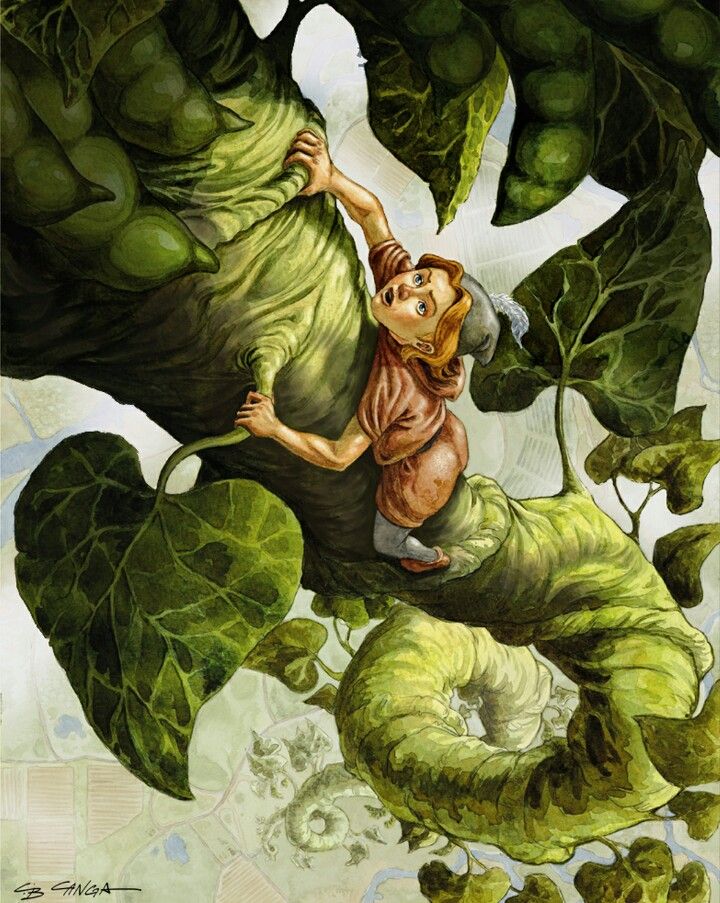
- Earth Sanction: Jack is punished, deprived of food (Jack is hungry). NIGHT: Jack sleeps.
- The magic happens: a stalk of a giant bean is found in the morning.
- Sky World:
- 1- e visit / 1- flight (Jack is very hungry): (a) Man-eating Jack's wife protects and hides in the furnace - (b) Ogre senses Jack: Phi-fi-fo- fum! ("Chorus Formula") - (c) Jack takes the bag of gold - (d) Ogre is unaware.
- 2- e visiting / 2- e stealing (Jack is hungry): (a) The ogre's wife doubts Jack and hides him in spite of everything in the oven - (b) F-f-f-fum! - (c) Jack takes the goose that lays the golden eggs - (d) Ogre in his house almost catches up with Jack.
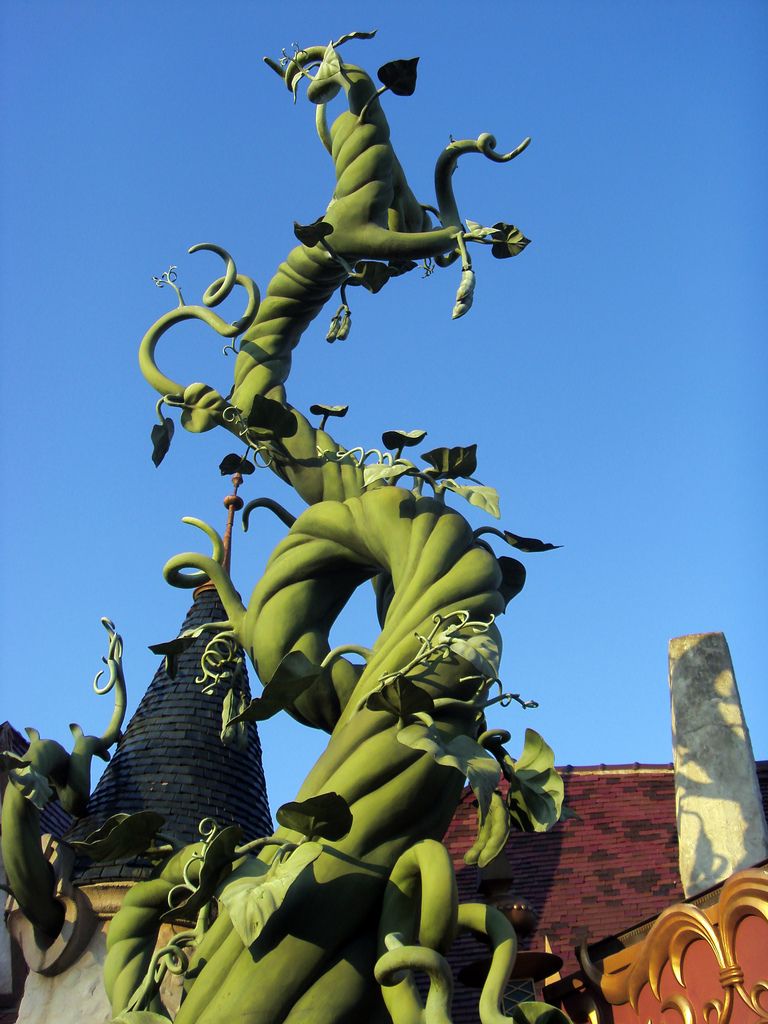
- 3 - visit / 3 e flight (Jack wants to find other treasures): (a) Jack is hiding in a pot - (b) Fee-fo-fum! - (a ') Ogre's wife condemns Jack - (c) Jack takes golden harp - (d) Ogre pursues Jack to wand.
- Conclusion: Fall and death of the ogre - Jack and his mother are rich and happy.
This plan includes several progressions, each of which takes place in three stages: in the earthly world, hunger becomes more acute (cash cow → beans → "going to bed without supper"), and in the heavenly world, hunger subsides until finally turns into a desire for more wealth, the ogre's wife gradually separates from Jack, and finally the danger posed by the ogre becomes more and more concrete.
Classification
Ogre fall.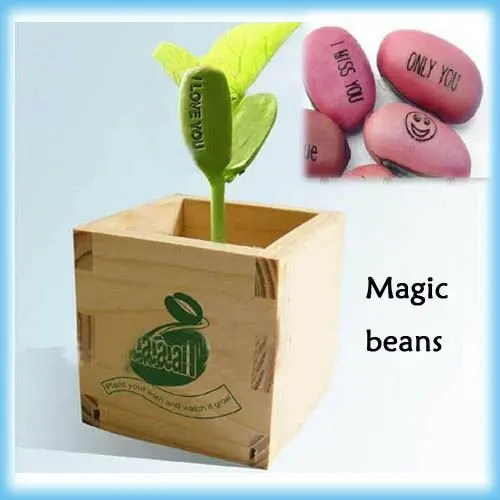 Illustration by Walter Crane.
Illustration by Walter Crane.
The tale is usually kept in Aarne-Thompson tales AT 328, corresponding to the type "The boy who steals the ogre's treasure". However, one of the main elements of the tale, namely the bean stalk, does not occur in other tales in this category. Beanstalk , similar to the one that appears in Jack and the Beanstalk , is found in other typical tales such as AT 563, "Three Magic Objects" and AT 555, "The Fisherman and His Wife". Bean Ogre's fall, on the other hand, seems to be unique to Jack .
Formula "Fi-fi-fo-fum"
The formula appears in some versions of the story by Jack the Giant Killer ( XVIII - th ), and earlier, in Shakespeare's play King Lear (v.1605). We find echoes of this in the Russian fairy tale about Vasilisa the Most Beautiful , where the witch shouts: “Crazy! It smells like Russian here! (Crazy, Fu means "Phi! Pah!" In Russian).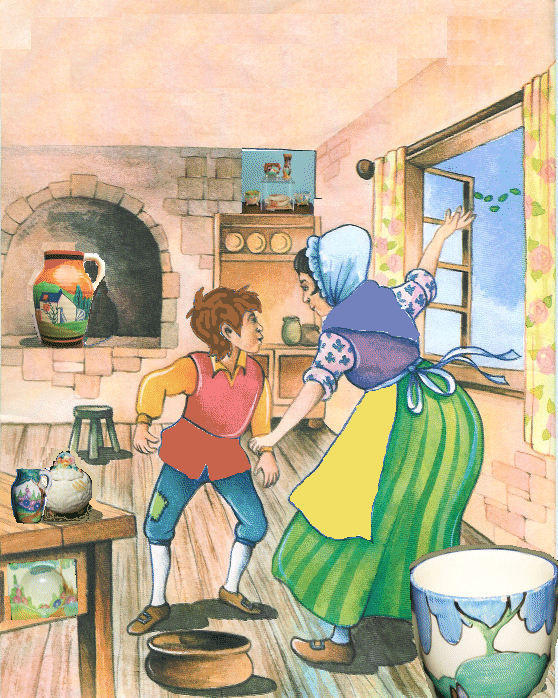
Parallels in other tales
Among other similar tales, such as tales AT 328 "The boy stealing the cannibal's treasure", we find, in particular, the Italian tale "The Thirteenth" and the Greek tale How the dragon was deceived . Corvetto , a tale that appeared in Giambattista Basile's Pentamerone (1634–1636), is also part of this type. It is about a young courtier who enjoys the favor of the king (of Scotland) and is the envy of the other courtiers, who therefore look for a way to get rid of him. Not far from there, in a fortified castle perched atop a mountain, lives an ogre, who is served by an army of animals and who keeps certain treasures that the king is likely to desire. The enemies of Corvetto force the king to send a young man in search of a cannibal, first a talking horse, then a tapestry. When a young man enters two victorious cases of his mission, they see to it that the king orders him to capture the ogre's castle. To complete this third mission, Corvetto introduces himself to the ogre's wife, who is busy preparing a feast; he offers to help her in her task, but instead kills her with an axe. Corvetto then manages to knock the ogre and all the guests of the feast into a hole dug in front of the castle gates. As a reward, the king finally extends the hand of his daughter to the young hero.
Corvetto then manages to knock the ogre and all the guests of the feast into a hole dug in front of the castle gates. As a reward, the king finally extends the hand of his daughter to the young hero.
The Brothers Grimm note the analogies between Jack and the Beanstalk and the German fairy tale The Devil's Three Golden Hairs (KGM 29), in which the devil's mother or grandmother acts in a manner quite comparable to the behavior of the cannibal's wives in Jack : a female figure, protecting the child from an evil male figure. In the version of the tale "Petit Puse" (1697), Perrault's wife also comes to the aid of Puse and his brothers.
The theme of a giant plant serving as a magical staircase between the earthly world and the heavenly world is also found in other fairy tales, especially in Russian ones, for example, in "Doctor Fox" .
The tale is unusual in that in some versions the hero, although an adult, does not marry at the end, but returns to his mother.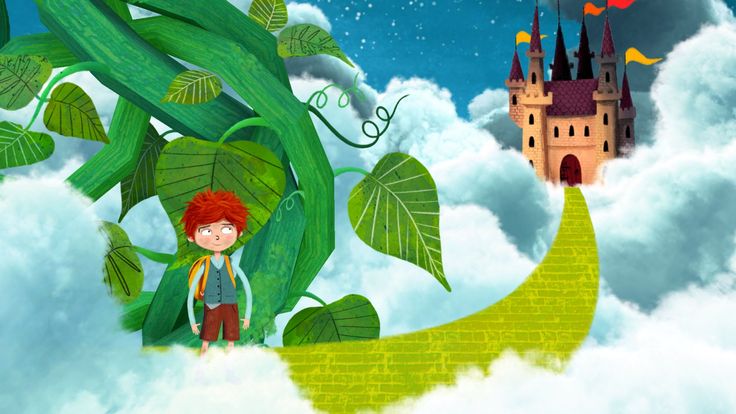 This feature occurs only in a small number of other tales, such as some variations of the Russian tale Vasilisa the Beautiful .
This feature occurs only in a small number of other tales, such as some variations of the Russian tale Vasilisa the Beautiful .
Patterns and ancient origins of these
The bean stalk seems to be a memory of the World Tree connecting Earth with Heaven, an ancient belief that existed in Northern Europe. This may be reminiscent of a Celtic tale, an ancient form of the Axis mundi , the original myth of the cosmic tree, a magical-religious symbolic link between Earth and Heaven, allowing sages to climb to the upper halves to know the secrets of the cosmos and the conditions of human life on earth. It is also reminiscent in the Old Testament of the Tower of Babel (Genesis 11:1-9) and the scale of Jacob's dream (Genesis 28:11-19) ascending to Heaven.
The victory of the "small" over the "great" is reminiscent of the episode of David's victory over the giant Philistine Goliath in the Old Testament ( First Kings 17:1-58). In the 1807 version of The Bat (1807), the "ogre" is beheaded, as was Goliath in the Old Testament story.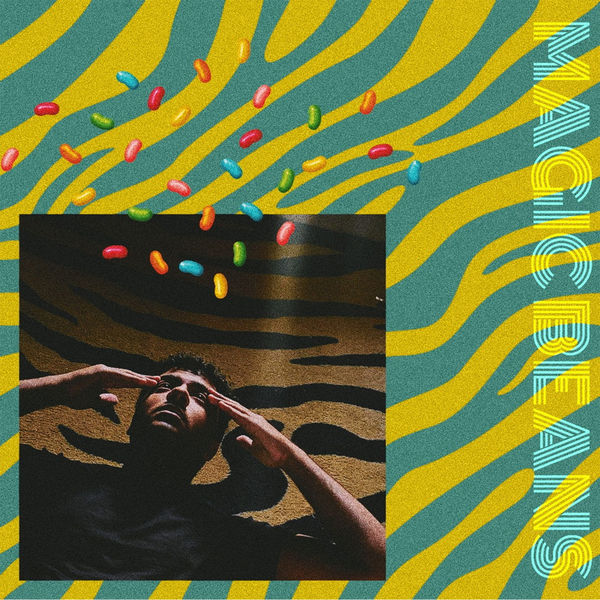
"The Goose that Lays the Golden Eggs", illustration for the Aesop fable by Milo Winter, taken from of the book "Isop for Children" . The motif of the "hen that lays the golden eggs" recurs in the fairy tale Jack and the Magic Bean .
Jack steals a goose that lays golden eggs, which resembles the goose with golden eggs of Aesop's fable (VII e - VI - th century BC), without coming to however this is Aesopian morality: no moral judgment is made on greed in Jack . Gold mining animals can be found in other tales such as the donkey in Peau d'âne or the donkey in Petite-table-sois-mise, Donkey-to-gold and Gourdin-sors-du. - bag , but a fact. The fact that in Jack the goose lays golden eggs does not play a special role in the development of the plot. In his Symbol Dictionary Jean Chevalier and Alain Gerbran note: “In the Celtic continental and insular tradition, the goose is the equivalent of the swan [.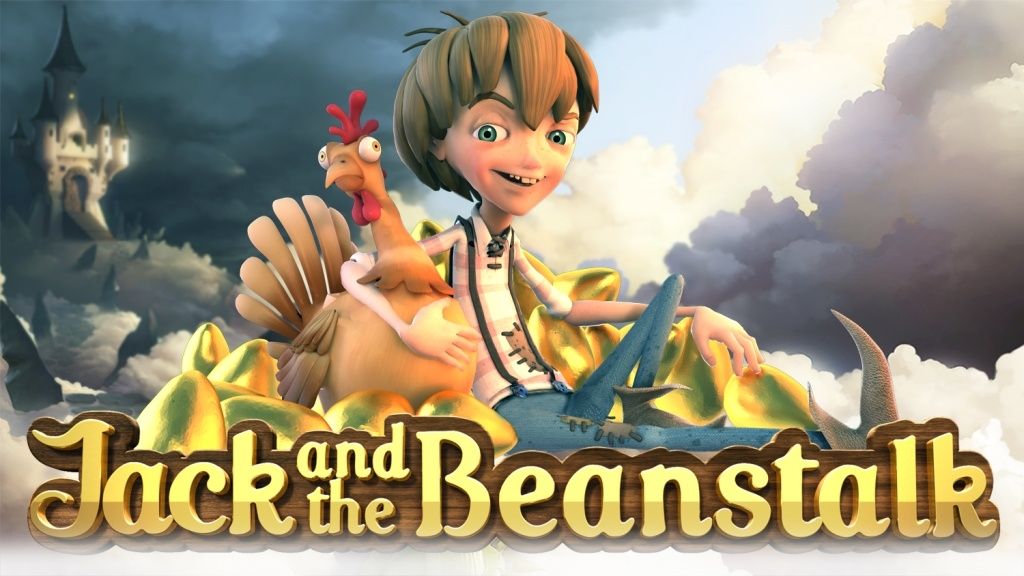 ..]. Considered a messenger from the Other World, among the Bretons he is the object of a ban on food, along with a hare and a chicken. "
..]. Considered a messenger from the Other World, among the Bretons he is the object of a ban on food, along with a hare and a chicken. "
Jack also steals the golden harp. In the same Symbol Dictionary we can read that the harp “connects heaven and earth. The heroes of the Edda want to be burned with a harp on a funeral pyre: this will lead them to that world. This is the role of the psychiatrist, the harp does not fulfill it only after death; during earthly life, it symbolizes the tension between the material instincts, represented by its wooden frame and the ropes of the lynx, and the spiritual aspirations, represented by the vibrations of these ropes. They are harmonious only if they come from a well-regulated tension between all the energies of the being, this measured dynamism that symbolizes the balance of personality and self-control. "
Moral
The story shows a hero who shamelessly hides in a man's house and uses his wife's sympathy to rob him and then kill him. In Tabart's moralized version, the fairy explains to Jack that a giant stole and killed his father, and Jack's actions turn into justified retribution in the process.
In Tabart's moralized version, the fairy explains to Jack that a giant stole and killed his father, and Jack's actions turn into justified retribution in the process.
Meanwhile, Jacobs omits this excuse, relying on the fact that, according to his own recollection of a fairy tale heard in childhood, she was absent from it, and also on the idea that children know well, without this we should tell them in a fairy tale that theft and murder are "evil".
Many modern interpretations have followed Tabart and portrayed the giant as a villain, terrorizing little people and often stealing valuables to make Jack's behavior legal. For example, the film "The Goose Who Loves Golden Eggs" ( Jack and the Beanstalk , 1952), starring Abbott and Costello, blames Jack the giant for failure and poverty, making him guilty of theft, and little people from the lands at the foot of his dwelling, food, and possessions, including a goose that lays golden eggs, which in this version originally belonged to Jack's family.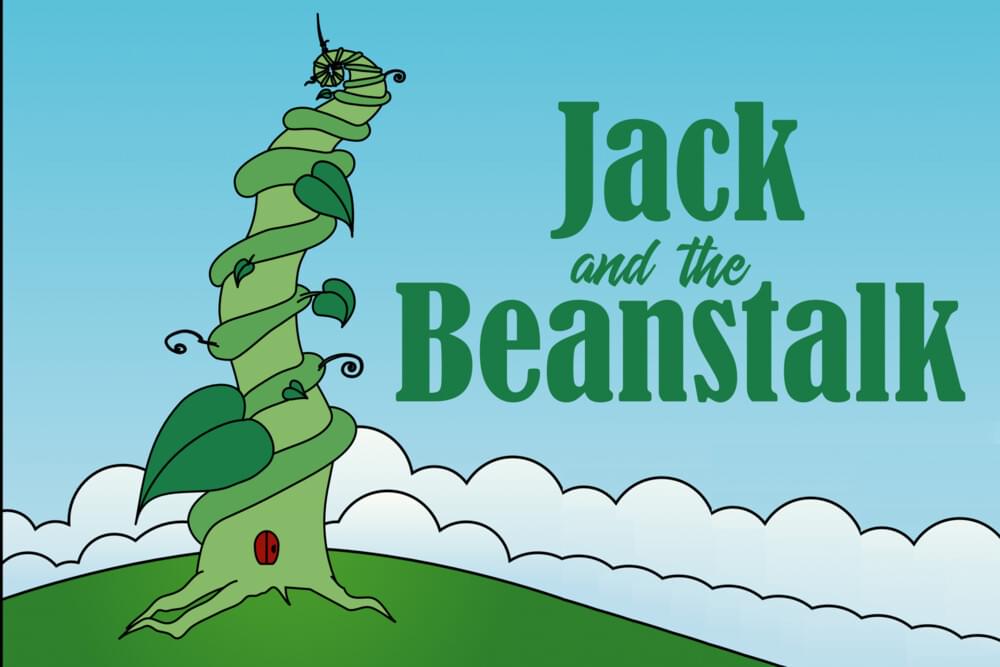 Other versions suggest that the giant stole the chicken and harp from Jack's father.
Other versions suggest that the giant stole the chicken and harp from Jack's father.
However, the moral of the tale is sometimes disputed. It is, for example, a subject of discussion in Richard Brooks' Seed of Violence ( Jungle on Plank , 1955), an adaptation of the novel by Evan Hunter (i.e. Ed McBain).
A mini-series made for television by Brian Henson in 2001, Jack and the Beanstalk ( Jack and the Beanstalk: The True Story ) gives an alternate version of the tale, leaving Tabart's additions aside. Here, Jack's character is significantly clouded, and Henson dislikes the morally dubious actions of the hero in the original tale.
Interpretations
There are different interpretations of this tale.
At first we can read Jack's exploits in the Middle Kingdom as a fairy tale. Indeed, it is at night when Jack, deprived of his supper, is asleep that a giant bean stalk appears, and it is not uncommon to see it as a fairy tale creation, spawned by his hunger and subsequent adventures, in part because of the guilt of failing him.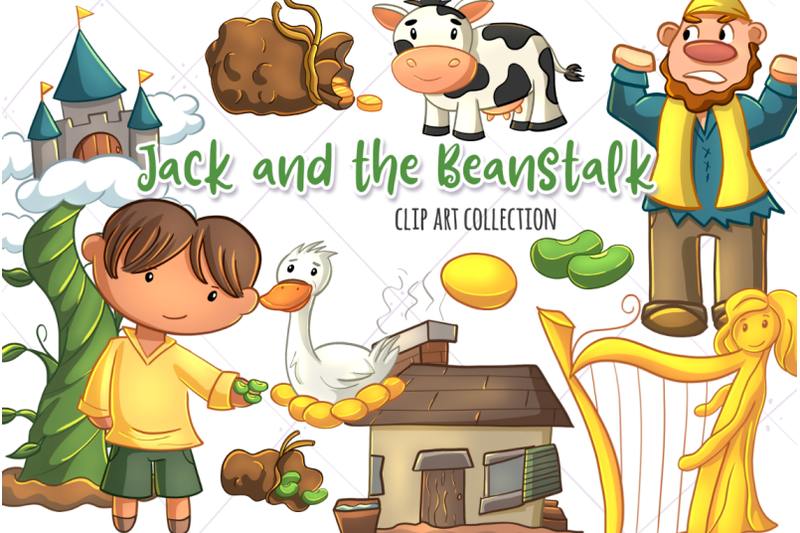 missions. The giantess, the ogre's wife, is a projection of Jack's mother in the dream, which can be interpreted as the fact that during Jack's first visit to the Skyworld, the giantess accepts her regarding her mother's protective behavior. The ogre thus represents the absent father, whose role was to provide both, Jack and his mother, with a livelihood, a role for which Jack is now called upon to replace him. In Skyworld, Jack joins his father-turned-giant and formidable shadow - the ogre - in competition with him, who seeks to eat him, and eventually sets about the task. Causing the ogre's death, he comes to terms with his father's death and realizes that it is his duty to the one who was initially presented as worthless to take over. In this way, he also breaks the bonds that bind and hold his mother captive to his father's memory.
missions. The giantess, the ogre's wife, is a projection of Jack's mother in the dream, which can be interpreted as the fact that during Jack's first visit to the Skyworld, the giantess accepts her regarding her mother's protective behavior. The ogre thus represents the absent father, whose role was to provide both, Jack and his mother, with a livelihood, a role for which Jack is now called upon to replace him. In Skyworld, Jack joins his father-turned-giant and formidable shadow - the ogre - in competition with him, who seeks to eat him, and eventually sets about the task. Causing the ogre's death, he comes to terms with his father's death and realizes that it is his duty to the one who was initially presented as worthless to take over. In this way, he also breaks the bonds that bind and hold his mother captive to his father's memory.
We can also interpret the story from a broader point of view. The giant that Jack kills before becoming the master of his fortune may represent the "big ones in this world" who exploit the "little people" and thereby provoke their rebellion, making Jack the hero of a sort of jacquerie.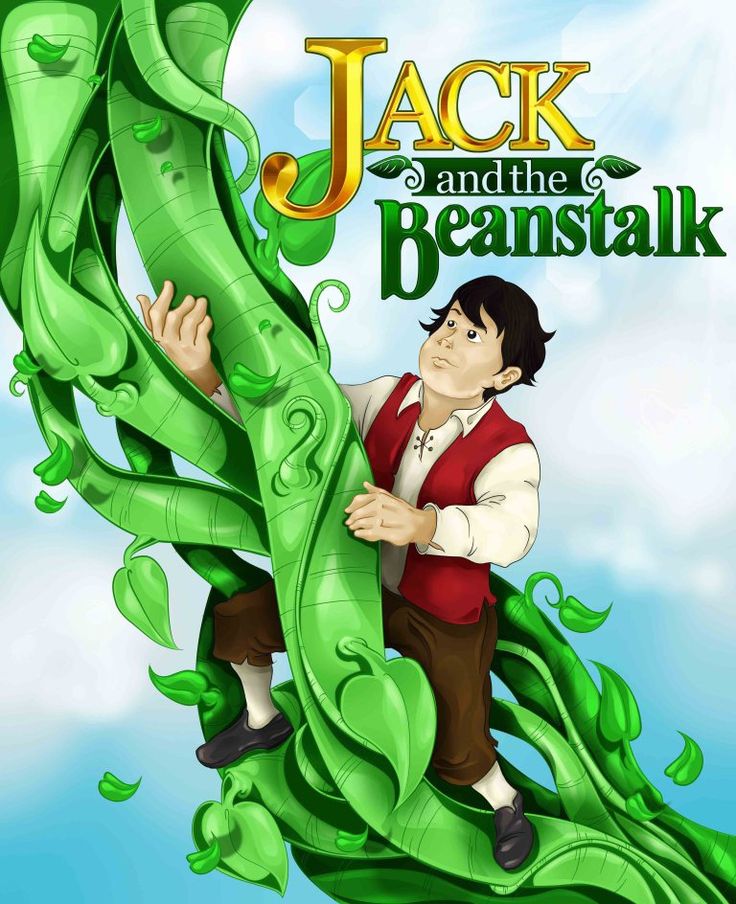
Vector illustrations
The tale, reprinted many times, was drawn by famous artists such as George Cruikshank (illustrator of Charles Dickens), Walter Crane or Arthur Rackham.
Modern fixtures
Movie
Jack and beanstalk (1917)
- 1902: Jack and the Beanstalk , a ten-minute short film produced by the Edison Manufacturing Company and directed by George S. Fleming and Edwin S. Porter, with Thomas White (Jack).
- 1912: Jack and the Beanstalk or Jack the Giant Killer , a short film directed by J. Searle Dawley, with Gladys Hewlett (Jack), Harry Eitinge (giant) and Gertrude McCoy.
- Jack and the Beanstalk , a short film with Leland Benham (Jack) and Helen Badgley.
- 1917: Jack and the Beanstalk , directed by Chester M. Franklin and Sidney Franklin, with Francis Carpenter (Jack), Jim J. Traver (giant), Virginia Lee Corbin, Jane Leigh, Katherine Leigh, Violet Radcliffe and Carmen de Ryu.
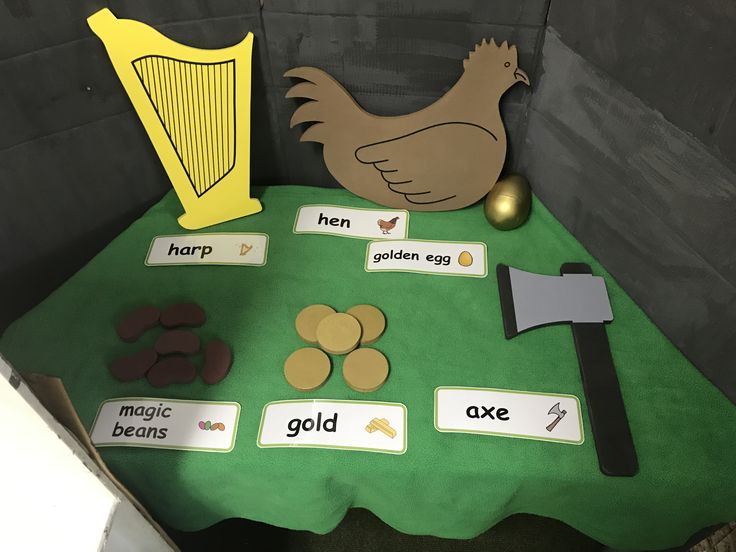
- 1922: Jack and the Beanstalk , produced and directed by Walt Disney.
- 1924: Jack and the Beanstalk , an animated short film directed by Herbert M. Dawley.
- 1924: Jack and the Beanstalk , short film directed by Alfred J. Goulding, with Baby Peggy and Blanche Payson.
- 1924: L'Ogre ( The Giant Killer ), a short film mixing live action footage and animation, directed by Walter Lantz, starring the character Dinky Doodle (a character created in 1916 and considered one of the first cartoon characters) .
- 1931: Jack and the Beanstalk , an animated short film directed by Dave Fleischer, starring Betty Boop.
- 1933: Mickey in Giantland ( Giantland ), an animated short produced by Walt Disney and directed by Barton Gillette, starring, as the name suggests, the character Mickey.
- 1933: Jack and the Beanstalk , an animated short film directed by Ub Iwerks and written by Ben Hardaway, collaboration with Sheamus Culhane, music by Carl W.
 Stalling (uncredited).
Stalling (uncredited). - 1943: Jack the Wabbit and the Beanstalk , an animated short film directed by Friz Freleng, music by Carl W. Stalling and starring the character Bugs Bunny.
- 1947: Mickey and the Beanstalk , episode from Disney's Spring Rogue , directed by Hamilton Luske and Bill Roberts, again starring the character Mickey.
- 1952: La Poule aux Eggs d'Or ( Jack and the Beanstalk ) produced in black and white for the modern part and in color for Jean Yarbrough's fantasy tale period with Lou Costello (Jack), Buddy Baer (giant), and Costello's lifelong friend, Bud Abbott.
- 1955: Jack and the Beanstalk or Jack the Giant Killer , a British short film (China Shadow technique) directed by Lotte Reiniger with music by Freddie Phillips.
- 1955: Seed of Violence by Richard Brooks, who integrates the cartoon Jack and the Magic Bean into his film to show Richard Dadier's character's heart for tolerance towards his students.
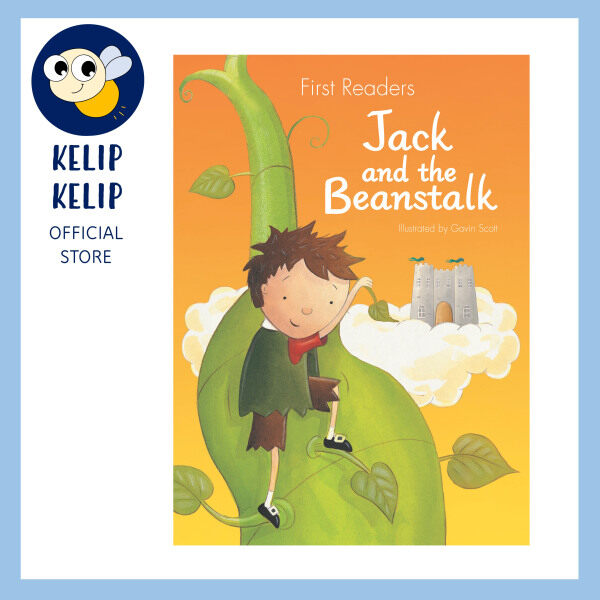
- 1967: Shônen Jakku to Mahô-tsukai (in the United States: Jack and the Witch ) is a Japanese animated film directed by Taiji Yabushita.
- 1970: Jack and the Beanstalk , directed by Barry Mahon, with Mitch Poulos (Jack) and Renato Boraquerro (giant).
- 1974: Jack and the Beanstalk , a Japanese-American animated film directed by Gisaburo Sugi.
- 2013: Jack the Giant Slayer ( Jack the Giant Slayer ), a feature film directed by Bryan Singer, with Nicholas Hoult as Jack.
- 2015: Into the Woods musical film featuring characters from fairy tales with Daniel Huttlestone as Jack.
- Tom and Jerry Jack and the Magic Bean
TV and video
- 1967: Jack and the Beanstalk ( Jack and the Beanstalk (1967) ), produced by Gene Kelly, William Hanna and Joseph Barbera, directed by Gene Kelly, Music by Lenny Hayton, with Gene Kelly, Bobby Riha (Jack) and Ted Cassidy (giant).
 The film, which is about fifty minutes long, combines real footage and animation, emphasizing music and dance.
The film, which is about fifty minutes long, combines real footage and animation, emphasizing music and dance. - 1973: The Goodies and Beanstalk , episode of the British TV series featuring the Goodies, a trio of actors consisting of Tim Brooke-Taylor, Graham Garden and Bill Oddy.
- 1974: Jack and the Beanstalk with Peter Jeffery.
- 1993: Jack and the Magic Bean (video), animated short film directed by Koji Morimoto, "Anime Art Video" compilation.
- 1998: Jack and the Beanstalk , a British television film directed by John Henderson and starring Neil Morrissey (Jack), Griff Rhys Jones and Peter Serafinowicz.
- 2001: Jack and the Beanstalk ( Jack and the Beanstalk: The True Story ), directed by Brian Henson, with Matthew Modine (Jack), Vanessa Redgrave, Mia Sarah, Daryl Hannah, Jon Voight and JJ Feild (Jack's child) .
- 2010: Jack and the Beanstalk , an American television film directed by Gary J.
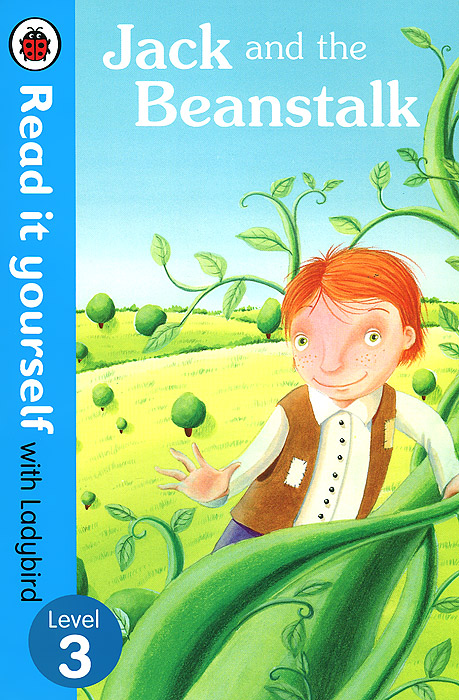 Tunnicliff and starring Colin Ford, Chloe Moretz and Christopher Lloyd.
Tunnicliff and starring Colin Ford, Chloe Moretz and Christopher Lloyd. - 2010: Simsala Grimm , German cartoon season 2 episode 1: Jack and the beanstalk (Hans und die Bohnenranke)
- 2013: TV series Once Upon a Time offers its own version of the tale. "Jack" here is a woman, and her real name is Jacqueline. In the universe of the series, Jacqueline allies with Prince James (charming's twin) and manipulates the giant into pretending to be his friends, rather than steal his wealth and magic beans;
- 2013: Tom and Jerry: Giant Beans , an animated television series featuring Tom and Jerry.
video games
- Attempt to adapt to Nintendo has been cancelled.
- There is an Amstrad CPC version.
- There is also a Commodore 64 version called Jack and the Beanstalk (© 1984, Thor Computer Software).
- In 2008, 24 Grimm stories were adapted into 24 episodes of a downloadable video game called American McGee's Grimm, created by American creator American McGee, also known for the game American McGee's Alice .
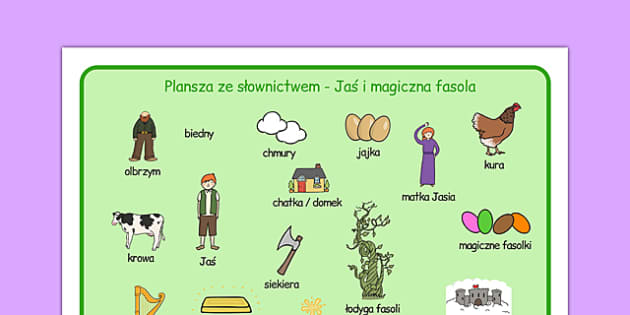 In a review of children's books for The Quarterly Review of 1842 and 1844 (volumes 71 and 74), Elizabeth Eastlake recommends a series of books beginning with Felix Summerlee's Treasury House [sic] [i.e. Henry Cole], including a book of England's traditional Children's Songs , Beauty and the Beast , Jack and the Beanstalk and other old friends, all charmingly performed and beautifully illustrated." - quoted by Summerfield (1980), pp. 35-52.
In a review of children's books for The Quarterly Review of 1842 and 1844 (volumes 71 and 74), Elizabeth Eastlake recommends a series of books beginning with Felix Summerlee's Treasury House [sic] [i.e. Henry Cole], including a book of England's traditional Children's Songs , Beauty and the Beast , Jack and the Beanstalk and other old friends, all charmingly performed and beautifully illustrated." - quoted by Summerfield (1980), pp. 35-52. - ↑ a b c and d (en) "The Story of Jack and the Beanstalk ", available from surlalunefairytales.com. — Page consulted June 12, 2010
- ↑ a and b Tatar (2002), p. 132.
- ↑ a and b Opie (1974).
- ↑ (in) The Story of Jack and the Beanstalk: Recording and Facsimile, about the Hockliff Project.
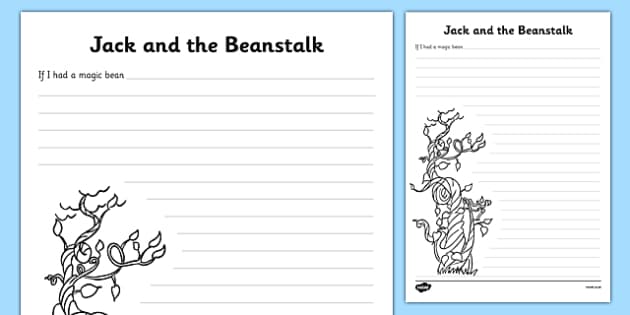 Tale collected by Johann Georg von Hahn in Griechische und Albanesische Märchen , 1854
Tale collected by Johann Georg von Hahn in Griechische und Albanesische Märchen , 1854 - ↑ (in) Corvetto at surlalune.com, English translation of the tale.
- ↑ (en) Jacob and Wilhelm Grimm (eds.), The Devil's Three Golden Hairs, in Selected Stories of the Brothers Grimm , trad. Frédéric Baudry, Hachette, Paris, 1900, p. 146 St. - Online at the Gallica website.
- ↑ (ru) William Ralston Shedden (ed.), "The Fox Doctor" in fairy tales popular in Russia , trans. Loys Brueyre, Hachette, Paris, 1874, p. 277 St. - Online at the Gallica website.
- ↑ (en) William Shedden Ralston (ed.
 ), "Vasilisa la Belle", in Popular Tales of Russia , trans. Loys Brueyre, Hachette, Paris, 1874, p. 147 St. - Online at the Gallica website.
), "Vasilisa la Belle", in Popular Tales of Russia , trans. Loys Brueyre, Hachette, Paris, 1874, p. 147 St. - Online at the Gallica website. - ↑ Tatarsky (1992), p. 199.
- ↑ Eliade (1952). 9Chevalier-Gheerbrant (1992), p. 392.
- ↑ Tatarsky (1992), p. 198.
- ↑ Nazzaro (2002), pp. 56-59.
- ↑ Cruikshank (1854).
- ↑ Crane (1875).
- ↑ Rackham (1913).
- ↑ (in) Jack and the Beanstalk , sealntera.com.
- ↑ a b and c Available in addition to DVD, Jack's Giant Fighter , MGM Home Entertainment - Ciné Malta, coll. "Cult & Underground", 2002. EAN 3-545020-008485.
- ↑ a and b Find out more.
- ↑ Title assigned to by Drive In Movie when announcing the broadcast of this film on August 10, 2018 at 9:00 pm.
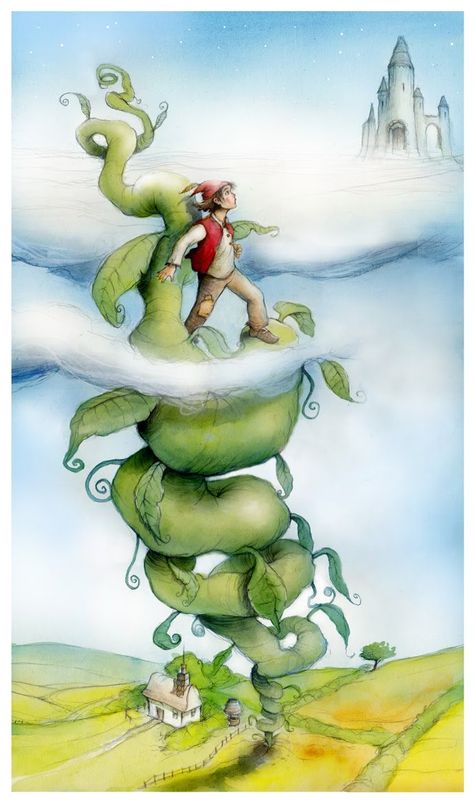 However, this title does not appear in the subtitles of the film produced by Bach Films.
However, this title does not appear in the subtitles of the film produced by Bach Films. - ↑ Process Super Color, mentioned in the credits.
- ↑ (in) Jack and the Beanstalk at Movie Database at Internet
- ↑ Downloadable version from catsuka.com.
- ↑ " TREMOLO EDITIONS PRODUCTIONS " on TREMOLO EDITIONS PRODUCTIONS (accessed March 22, 2016)
- ↑ " FGL Music - Jack and the Magic Bean - Tale Musical Pop Rock (Jack and the Magic Bean) ", available at www.fglmusic.com (accessed March 22, 2016)
- (en) [Crane] Jack and the Beanstalk , George Routledge and Sons, London, 1875.
 Jack and the Beanstalk, in Bluebeard picture book , Walter Crane, ill., George Routledge and Sons , London, [ca. 1875]. - Send online text messages with a fax at the University of Southern Mississippi (USM) website.
Jack and the Beanstalk, in Bluebeard picture book , Walter Crane, ill., George Routledge and Sons , London, [ca. 1875]. - Send online text messages with a fax at the University of Southern Mississippi (USM) website. - (en) George Cruikshank (ed., ill.), "The Story of Jack and the Beanstalk", in Fairy Library , David Bog, London, [c.1853-1854]. — Notice and facsimile of mutilated copy at The Hockliffe Project website.
- (en) [Heartland] "Jack and the Beanstalk", in Edwin Sidney Heartland (ed.), English Tales and Other Folk Tales , Walter Scott Publishing Company, London, [c.1890]. - Send text messages online at surlalune.com.
- (en) [Jacobs] "Jack and the Beanstalk", Joseph Jacobs (ed.
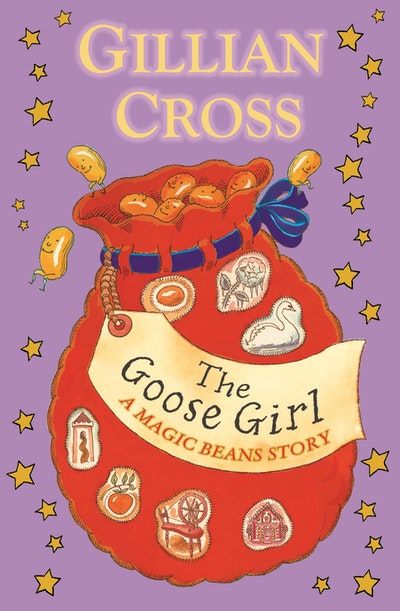 ), English Tales , David Nutt, London, 1890. - Text online at surlalune.com.
), English Tales , David Nutt, London, 1890. - Text online at surlalune.com. - (en) [Lang] "Jack and the Beanstalk", in Andrew Lang (ed.), The Red Fairy Book , Longmans, Green and Company, London, 1890. - Text online at surlalune.com.
- (en) [McLaughlin] Jack and the Beanstalk, R. Andre (?) ill., McLaughlin Brothers, Sat. "Young Men Series", New York, 1888.
- (en) [Nesbit] "Jack and the Beanstalk", in E. Nesbit, "Old Children's Stories" , ill. W. H. Margetson, Henry Froude and Hodder and Stoughton, Sat. "Children's Bookcase", London 1908. - Text online with facsimile at the University of Southern Mississippi (USM) website.
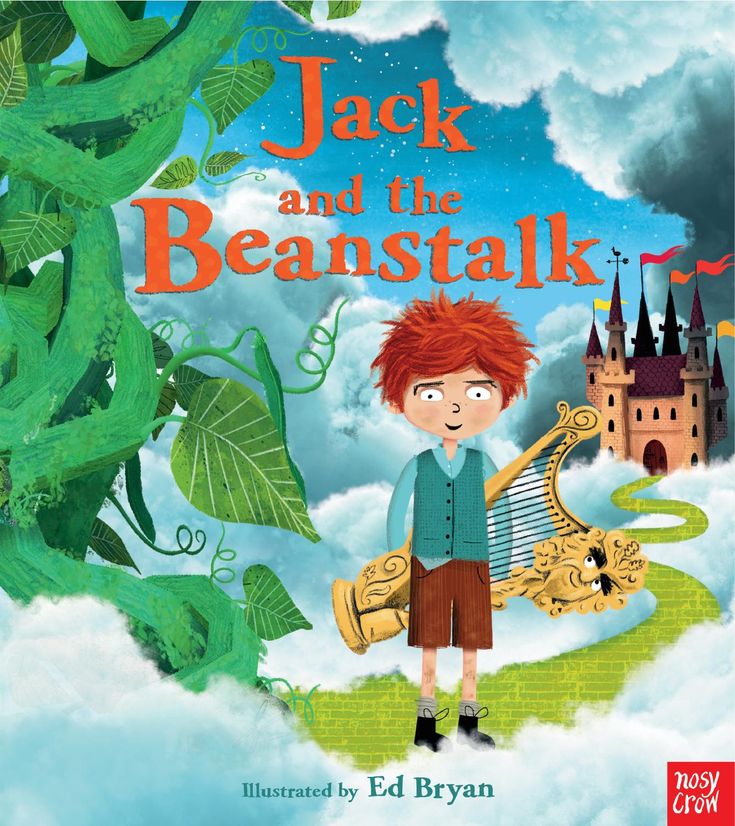
- (en) [Orr] "Jack and the Beanstalk", in "Stories of Jack and the Beanstalk [ and Michael Scott ]", Francis Orr & Sons, Glasgow, [1820]. - Send online text messages with a fax at the University of Southern Mississippi (USM) website.
- (en) [Park] The Amazing Story of Jack and the Beanstalk, which details his travels through the beanstalk, how he got hold of the sacks of gold, and how he killed the ogre by chopping down the bean. stem , A. Park, London, [c.1840]. - Notice and facsimile on the Hockliffe Project website.
- (en) [Parsons] "Jack and the Beanstalk", in Elsie Clews Parsons (ed.
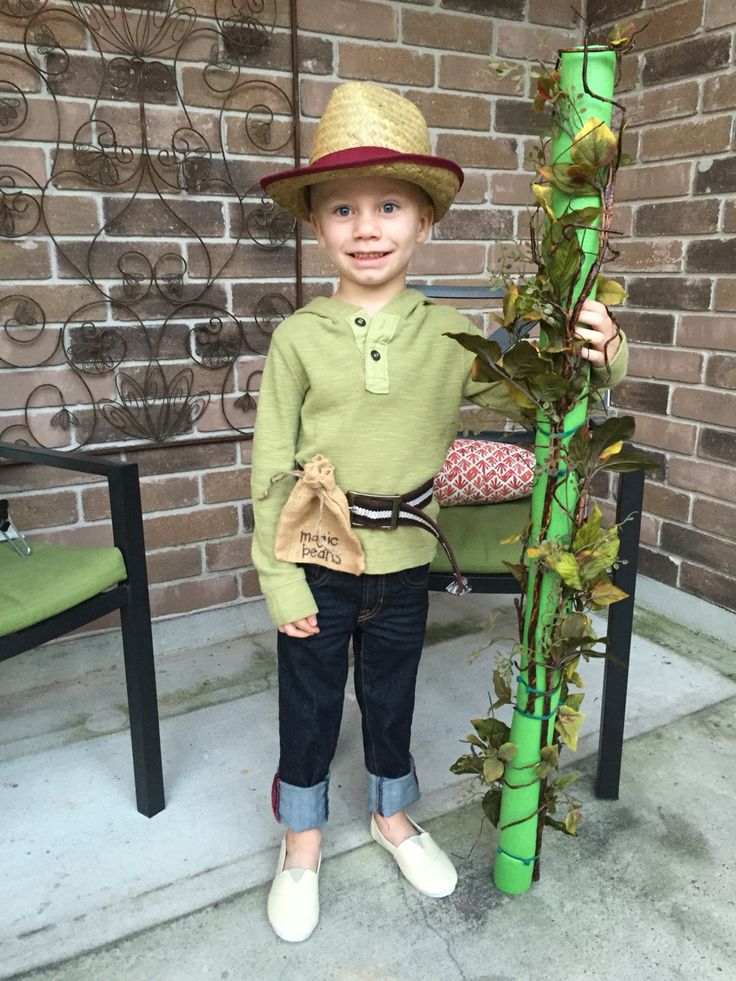 ), "Tales from Maryland and Pennsylvania", in Journal of American Folklore , vol. 30, n o 116 (April ). - Send text messages online at surlalune.com.
), "Tales from Maryland and Pennsylvania", in Journal of American Folklore , vol. 30, n o 116 (April ). - Send text messages online at surlalune.com. - (en) Arthur Rackham, Arthur Rackham Picture Book , W. Heinemann, London, 1913.
- (en) [Reynolds] "Jack and the Beanstalk: A New Version", in Jack and the Beanstalk, and Little Jane and Her Mother , William J. Reynolds & Co., Boston, 1848]. - Send online text messages with a fax at the University of Southern Mississippi (USM) website.
- (en) [Tabart] The Story of Jack and the Beanstalk , Benjamin Tabart - Juvenile and School Library, London 1807 - Notice and facsimile on the website of The Hawcliffe Project.

- (en) [Vredenberg] "Jack and the Beanstalk", in Edric Vredenberg et al. (ed.), Old Tales , Francis Brundage, E. J. Andrews et al. ill., Raphael Tuck & Sons, London, [before 1919]. - Send online text messages with a fax at the University of Southern Mississippi (USM) website.
- (en) Christine Goldberg, "Composition Jack and the Beanstalk ", at Marvels & Tales , vol. 15, No 1 (2001), pp. 11-26. - Online at the Project Muse website.
- (en) Matthew Orville Granby, "Tame Fairies Are Good Teachers: The Popularity of Early British Fairy Tales", in The Lion and the Unicorn , 30.
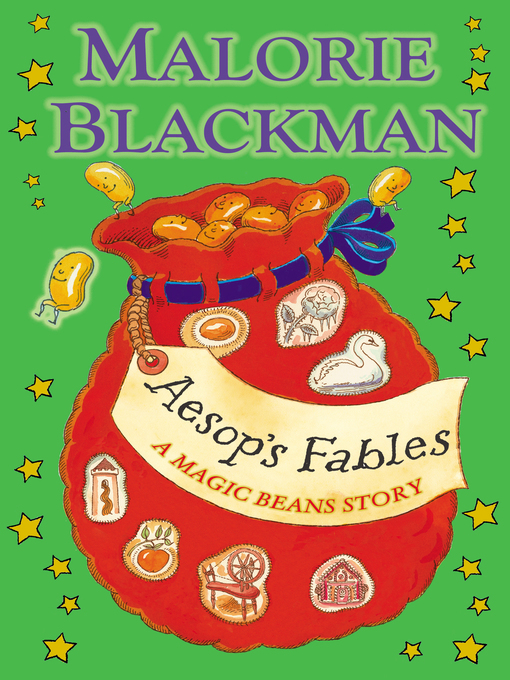 1 ().
1 (). - (en) Jonah and Peter Opie, Classic Tales , New York, Oxford University Press, New York, 1974.
- ( fr ) Geoffrey Summerfield, "Building a Home Treasury", at Children's Literature , 8 (1980).
- (en) Maria Tatar, Annotated Classical Fairy Tales , W.W. Norton, 2002 (ISBN 0-393-05163-3) .
- (ru) Maria Tatarka, chop off their heads! : Fairy Tales and the Culture of Childhood , Princeton University Press, Princeton, 1992 (ISBN 0-691-06943-3) .
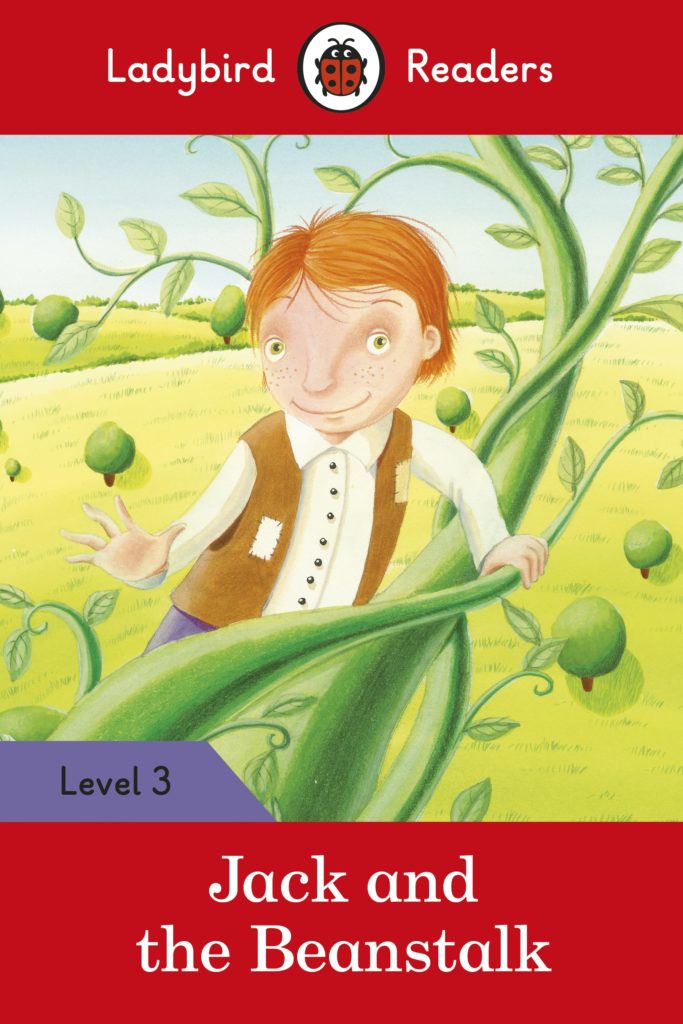
- (fr) Jean Chevalier, Alain Gerbrant, Dictionary of Symbols: Myths, Dreams, Customs, Gestures, Forms, Figures, Colors, Numbers , Robert Laffon, Paris, ac. showing 1992. (ISBN 2-221-01053-1) .
- (fr) Mircea Eliade, Images and symbols , Gallimard, coll. "Tel 44", Paris 1992 (ISBN 9-782070-286652) . Chapter “Symbols of the “center””, p. 33-72 and, in particular, p. 59-65: "The symbolism of the Ascension". - Ed. gold. : coll. "Essays", 1952.
- (en) Joe Nazzaro, "Back to the Beanstalk", in Starlog Fantasy Worlds , .
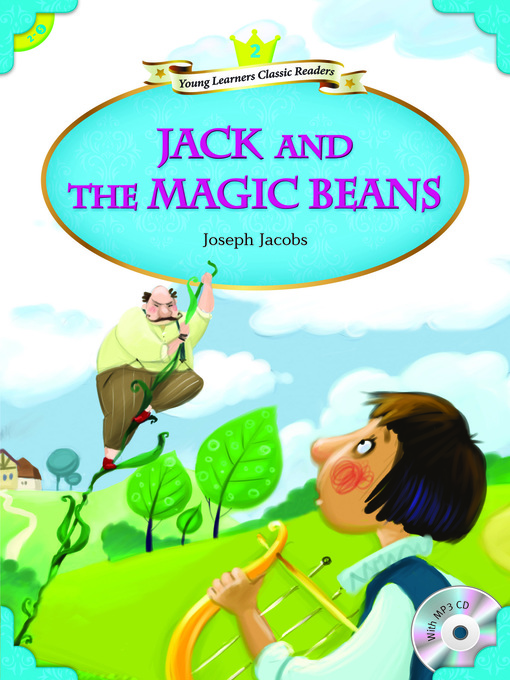
- Tale
- Oggy the girl and the beans
Bibliography
Versions / editions of the tale
Research
Symbolic
About adaptation
See also
Related Articles
Jack and the beanstalk is an English fairy tale. The story of the boy Jack.
A tale about a poor widow's son, Jack, who traded his family's only breadwinner, a cow, for magic beans. With the help of them and their ingenuity, Jack and his mother got rich.
Once upon a time there lived a poor widow. She had an only son named Jack and a cow named Belyanka. The cow gave milk every morning, and the mother and son sold it in the bazaar - this is how they lived. But suddenly Belyanka stopped milking, and they simply did not know what to do.
— How can we be? What to do? the mother repeated in despair.
— Cheer up, mother! Jack said. - I'll get someone to work with.
— Yes, you already tried to get hired, but no one hires you, — answered the mother.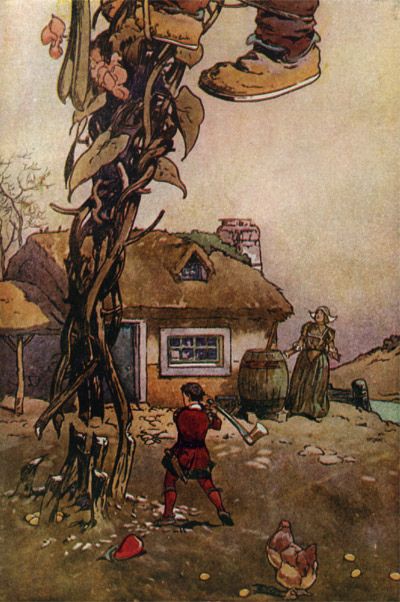 “No, apparently, we will have to sell our Belyanka and open a shop with this money.
“No, apparently, we will have to sell our Belyanka and open a shop with this money.
“Okay, Mom,” Jack agreed. - Today is just a market day, and I will quickly sell Belyanka. And then we'll decide what to do.
And Jack took the cow to the market. But before he had gone far, he met a funny, funny old man, and he said to him:
— Good morning, Jack!
— Good morning to you too! - Jack answered, and was surprised to himself: how does the old man know his name.
— Well, Jack, where are you going? asked the old man.
- To the market, to sell a cow.
— Yes, yes! Who should trade cows if not you! the old man laughed. “Tell me, how many beans do I have?”
- Exactly two in each hand and one in your mouth! - answered Jack, apparently, not a small mistake.
- That's right! said the old man. “Look, here are those beans!” And the old man showed Jack some strange beans. “Since you’re so smart,” the old man continued, “I’m not averse to trading with you—I’m giving these beans for your cow!”
- Go on your way! Jack got angry. “That would be better!”
“That would be better!”
"Uh, you don't know what beans are," said the old man. “Plant them in the evening, and by morning they will grow to the sky.
— Yes, well? Truth? Jack was surprised.
- The real truth! And if not, take your cow back.
- Coming! - Jack agreed, gave the old man Belyanka, and put the beans in his pocket.
Jack turned back home, and since he did not have time to go far from home, it was not dark yet, and he was already at his door.
— How are you back, Jack? mother was surprised. - I see Belyanka is not with you, so you sold her? How much did they give you for it?
- You'll never guess, Mom! Jack answered.
— Yes, well? Oh my good! Five pounds? Ten? Fifteen? Well, twenty something will not give!
- I said - you can't guess! What can you say about these beans? They are magical. Plant them in the evening and...
— What?! cried Jack's mother. “Are you really such a simpleton that you gave my Belyanka, the most milking cow in the whole area, for a handful of some bad beans?” It is for you! It is for you! It is for you! And your precious beans will fly out the window.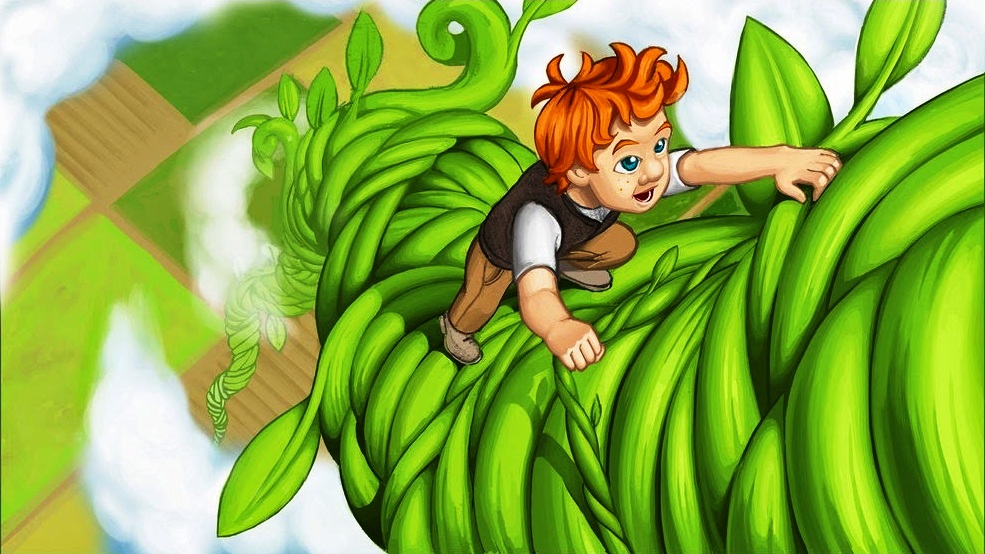 So that! Now live to sleep! And don’t ask for food, you won’t get it anyway - not a piece, not a sip!
So that! Now live to sleep! And don’t ask for food, you won’t get it anyway - not a piece, not a sip!
And then Jack went up to his attic, to his little room, sad, very sad: he angered his mother, and he himself was left without supper. Finally, he did fall asleep.
And when he woke up, the room seemed very strange to him. The sun illuminated only one corner, and everything around remained dark, dark. Jack jumped out of bed, dressed and went to the window. And what did he see? What a strange tree! And these are his beans, which his mother threw out of the window into the garden the day before, sprouted and turned into a huge bean tree. It stretched all the way up, up and up to the sky. It turns out that the old man was telling the truth!
The beanstalk grew just outside Jack's window and went up like a real staircase. So Jack had only to open the window and jump onto the tree. And so he did. Jack climbed the beanstalk and climbed and climbed and climbed and climbed and climbed and climbed until he finally reached the sky.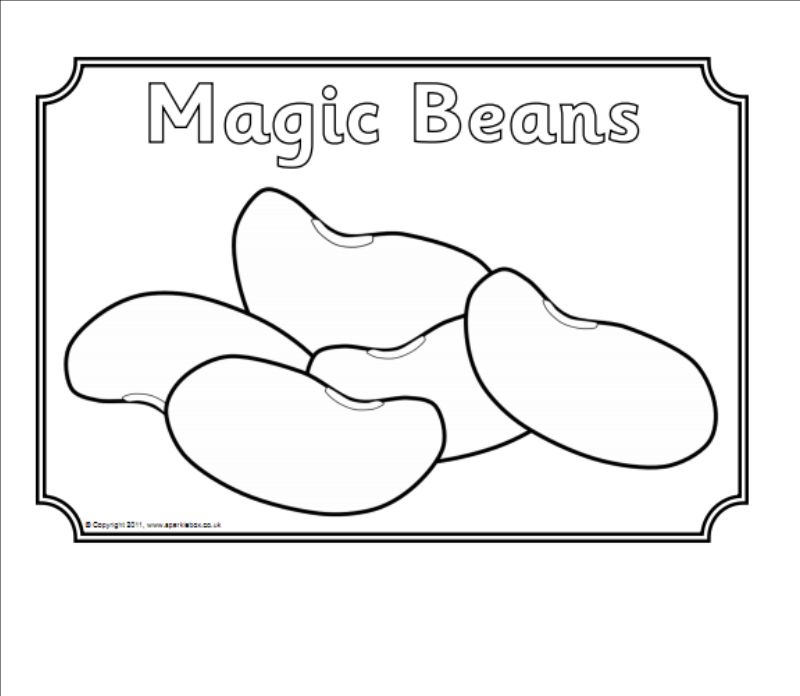 There he saw a long and wide road, as straight as an arrow. I went along this road and kept walking and walking and walking until I came to a huge, huge tall house. And at the threshold of this house stood a huge, enormous, tall woman.
There he saw a long and wide road, as straight as an arrow. I went along this road and kept walking and walking and walking until I came to a huge, huge tall house. And at the threshold of this house stood a huge, enormous, tall woman.
— Good morning, ma'am! Jack said very politely. “Be so kind as to give me breakfast, please!”
After all, the day before Jack had been left without supper, you know, and now he was as hungry as a wolf.
— Would you like to have breakfast? - said a huge, enormous, tall woman. “You yourself will get another for breakfast if you don’t get out of here!” My husband is a giant and a cannibal, and he loves nothing more than boys fried in breadcrumbs.
— Oh, madame, I beg you, give me something to eat! Jack didn't hesitate. “I haven’t had a crumb in my mouth since yesterday morning. And it doesn't matter if they fry me or I'll die of hunger.
Well, the ogre's wife was not a bad woman after all. So she took Jack to the kitchen and gave him a piece of bread and cheese and a jug of fresh milk.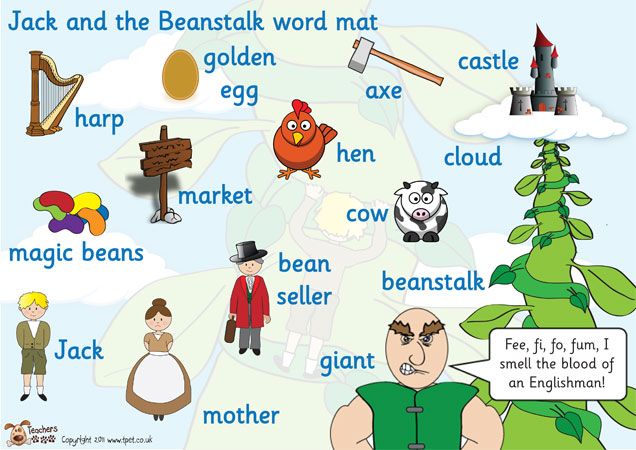 But before Jack had time to finish with half of all this, when suddenly - top! Top! Top! - the whole house even shook from someone's steps.
But before Jack had time to finish with half of all this, when suddenly - top! Top! Top! - the whole house even shook from someone's steps.
- Oh my God! Yes, that's my old man! gasped the giantess. - What to do? Hurry, hurry, jump over here!
And just as she pushed Jack into the oven, the ogre himself entered the house.
Well, he was really great! Three calves dangled from his belt. He untied them, threw them on the table and said:
— Come on, wife, fry me a couple for breakfast! Wow! What does it smell like?
Fi-fi-fo-foot,
I smell the spirit of the British here.
Whether he is dead or alive,
He will be included in my breakfast.
— What are you, hubby! his wife told him. - You've got it. Or maybe it smells like that lamb that you liked so much yesterday at dinner. Come on, wash your face and change, and in the meantime I will prepare breakfast.
The ogre came out and Jack was about to get out of the oven and run away, but the woman wouldn't let him.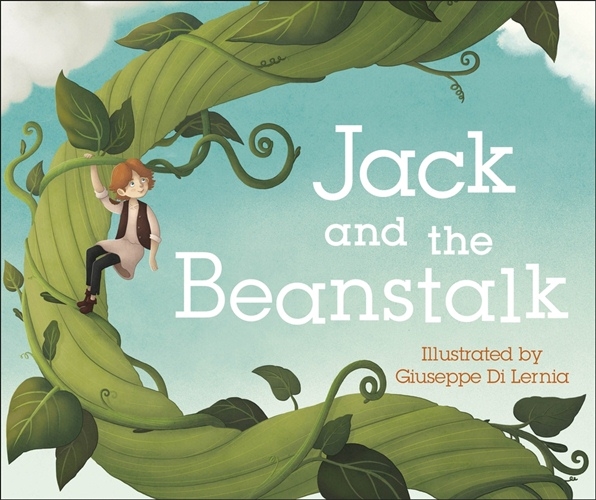
“Wait until he falls asleep,” she said. He always likes to take a nap after breakfast.
And so the giant had breakfast, then went to a huge chest, took out two sacks of gold from it and sat down to count the coins. He counted and counted, finally began to nod off and began to snore so that the whole house began to shake again.
Then Jack slowly got out of the oven, tiptoed past the sleeping ogre, grabbed one bag of gold and God bless! — straight to the beanstalk. He dropped the bag down into his garden, and he began to descend the stem, lower and lower, until at last he found himself at home.
Jack told his mother about everything, showed her a bag of gold and said:
— Well, Mom, did I tell the truth about these beans? You see, they are really magical!
“I don’t know what these beans are,” answered the mother, “but as for the cannibal, I think it’s the one who killed your father and ruined us!”
And I must tell you that when Jack was only three months old, a terrible ogre appeared in their area.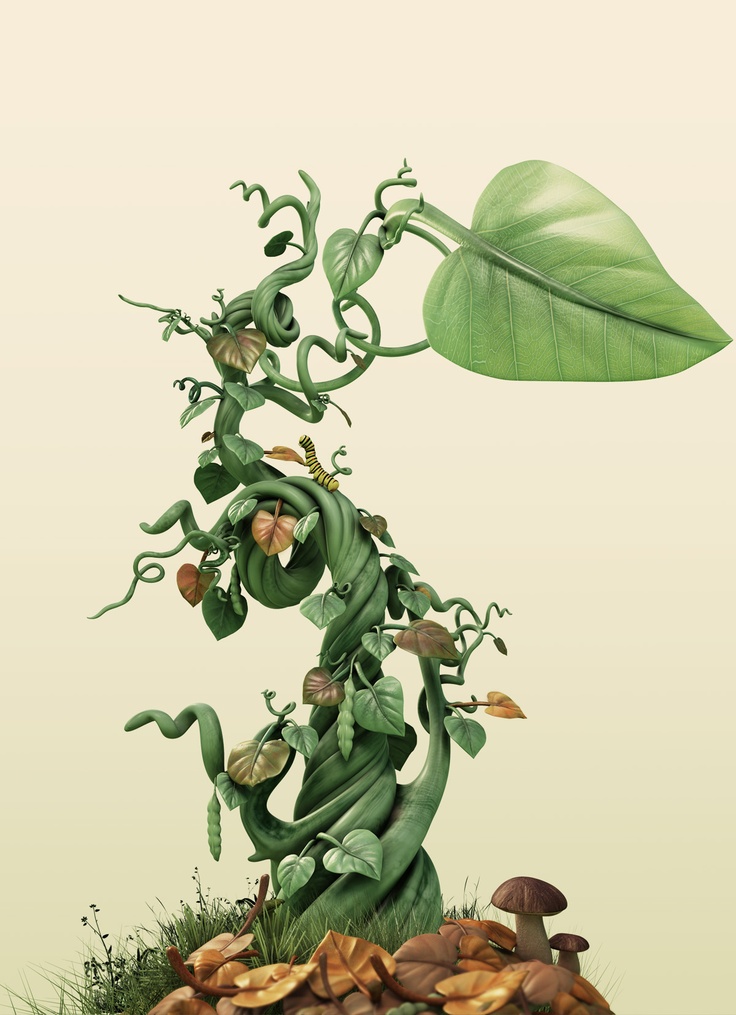 He grabbed anyone, but especially did not spare the kind and generous people. And Jack's father, although he was not rich himself, always helped the poor and the losers.
He grabbed anyone, but especially did not spare the kind and generous people. And Jack's father, although he was not rich himself, always helped the poor and the losers.
“Oh, Jack,” the mother finished, “to think that the cannibal could eat you too!” Don't you dare climb that stem ever again!
Jack promised, and they lived with their mother in full contentment with the money that was in the bag.
But in the end the bag was empty, and Jack, forgetting his promise, decided to try his luck at the top of the beanstalk one more time. One fine morning he got up early and climbed the beanstalk. He climbed, and climbed, and climbed, and climbed, and climbed, and climbed, and climbed, until he finally found himself on a familiar road and reached along it to a huge, enormous tall house. Like last time, a huge, enormous, tall woman was standing at the threshold.
“Good morning, ma'am,” Jack told her as if nothing had happened. “Be so kind as to give me something to eat, please!”
- Get out of here, little boy! the giantess replied.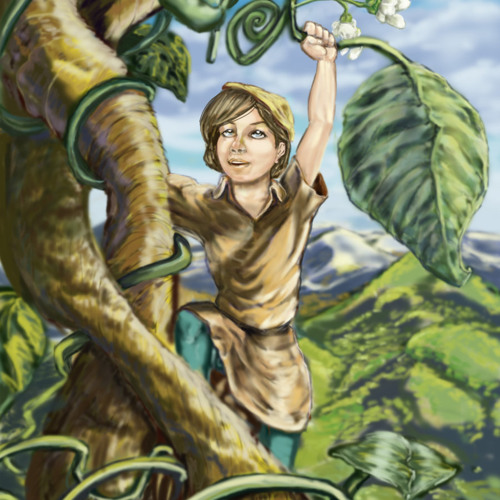 “Or my husband will eat you at breakfast.” Uh, no, wait a minute, aren't you the youngster who came here recently? You know, on that very day my husband missed one sack of gold.
“Or my husband will eat you at breakfast.” Uh, no, wait a minute, aren't you the youngster who came here recently? You know, on that very day my husband missed one sack of gold.
— These are miracles, ma'am! Jack says. “It’s true, I could tell you something about it, but I’m so hungry that until I eat at least a piece, I won’t be able to utter a word.
The giantess was so curious that she let Jack into the house and gave him something to eat. And Jack deliberately began to chew slowly, slowly. But suddenly - top! Top! Top! they heard the steps of the giant, and the kind woman again hid Jack in the oven.
Everything happened just like last time. The ogre came in and said: “Fi-fi-fo-foot…” and so on, had breakfast with three roasted bulls, and then ordered his wife:
- Wife, bring me a chicken - the one that lays the golden eggs!
The giantess brought it, and he said to the hen: “Come on!” And the hen laid a golden egg. Then the cannibal began to nod and began to snore so that the whole house shook.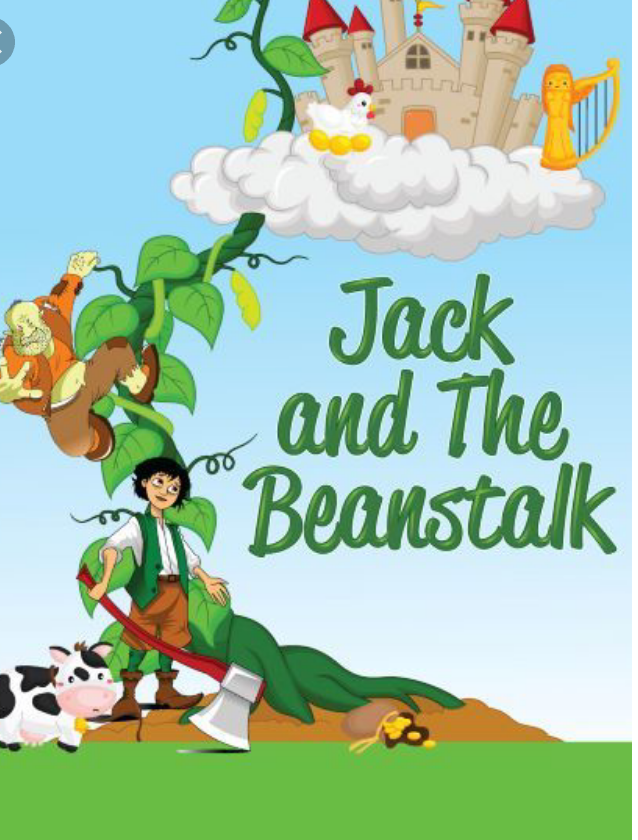
Then Jack slowly got out of the oven, grabbed the golden hen and was out the door in no time. But then the hen cackled and woke up the ogre. And just as Jack was running out of the house, he heard the giant's voice behind him:
— Wife, leave the golden hen alone! And the wife answered:
- Why are you, my dear!
That's all Jack could hear. He rushed with all his might to the beanstalk and almost flew down it.
Jack returned home, showed his mother the miracle chicken and shouted: "Go!" And the hen laid a golden egg.
Since then, every time Jack told her, "Rush!" The hen laid a golden egg.
Mother scolded Jack for disobeying her and going to the cannibal again, but she still liked the chicken.
And Jack, a restless guy, after a while decided to try his luck again at the top of the beanstalk. One fine morning he got up early and climbed the beanstalk.
He climbed and climbed and climbed and climbed until he reached the very top.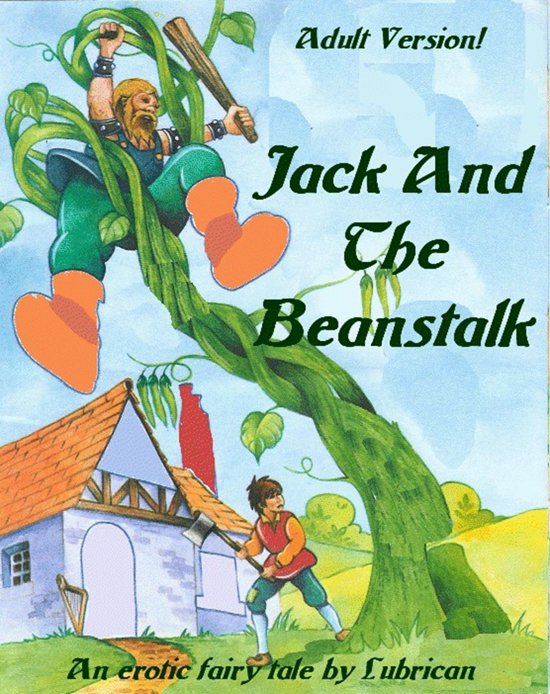 True, this time he acted more carefully and did not go straight to the cannibal's house, but crept up slowly and hid in the bushes. I waited until the giantess came out with a bucket for water, and darted into the house! I climbed into the copper cauldron and waited. He didn’t wait long, suddenly he hears the familiar “top! Top! Top!", and now the ogre and his wife enter the room.
True, this time he acted more carefully and did not go straight to the cannibal's house, but crept up slowly and hid in the bushes. I waited until the giantess came out with a bucket for water, and darted into the house! I climbed into the copper cauldron and waited. He didn’t wait long, suddenly he hears the familiar “top! Top! Top!", and now the ogre and his wife enter the room.
- Fi-fi-fo-foot, I smell the spirit of the British here! shouted the cannibal. “I can smell it, wife!”
— Can you really hear it, hubby? says the giantess. “Well, then, this is the tomboy who stole your gold and the goose with golden eggs. He's probably in the oven.
And both rushed to the stove. Good thing Jack wasn't hiding there!
- Always you with your fi-fi-fo-foot! grumbled the ogre's wife, and began preparing breakfast for her husband.
The ogre sat down at the table, but still could not calm down and kept mumbling:
— Still, I can swear that… — He jumped up from the table, rummaged through the pantry, and chests, and sideboards…
He searched all the corners, only he didn’t guess to look into the copper cauldron.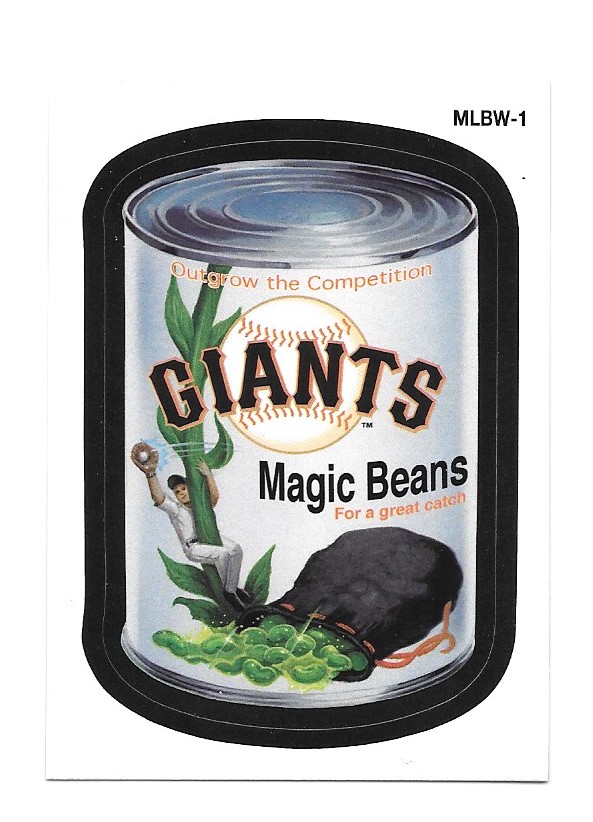 Finally finished breakfast and shouted:
Finally finished breakfast and shouted:
- Hey, wife, bring me a golden harp! The wife brought the harp and put it on the table.
- Sing! the giant ordered the harp.
And the golden harp sang so well that you will hear it! And she sang and sang until the ogre fell asleep and snored like thunder.
It was then that Jack lightly lifted the lid of the cauldron. He got out of it quietly, quietly, like a mouse, and crawled on all fours to the very table. He climbed onto the table, grabbed the harp, and rushed to the door.
But the harp called loudly:
— Master! Master!
The ogre woke up and immediately saw Jack running away with his harp.
Jack ran headlong, and the giant followed him. It cost him nothing to catch Jack, but Jack was the first to run, and therefore he managed to dodge the giant. And besides, he knew the road well. When he reached the bean tree, the ogre was only twenty paces away. And suddenly Jack was gone. Cannibal here, there - no Jack! Finally, he thought to look at the beanstalk and sees: Jack is trying with his last strength, crawling down.

